Leon – Nicaragua’s Most Interesting City
This is my sixth and final post on the poorest country we will visit on this Adventures Abroad exclusive trip to Central America specially designed and led by ace guide Victor Romagnoli. In my first post I provided a synopsis of what I liked and didn’t like about Nicaragua with the ledger coming down far more on the positive side than the negative. One of the places that really struck me as worthy of visiting was the old colonial city of Leon, perpetual rival to Granada and to me, the better of the two. While Granada’s beautiful yellow and rust red cathedral and the plaza that surrounds it outshines Leon’s all white version, in almost every other respect Leon comes out ahead. In my opinion here’s why Leon is the most interesting city in Nicaragua and maybe all of Central America.
The History of León
On our way to the present day location of Leon we stopped at Leon Viejo, a UNESCO World Heritage Site that perfectly preserves a Spanish colonial city in the state it was left in after the original inhabitants got tired of worrying about eruptions from Momotombo volcano and moved 20 miles (32 kms.) further west. This original city was founded in 1524 by Francisco Hernández de Córdoba for whom the Nicaraguan currency unit is named, but the Leon we will be exploring in this post dates from 1610 when the move from Leon Viejo was made.
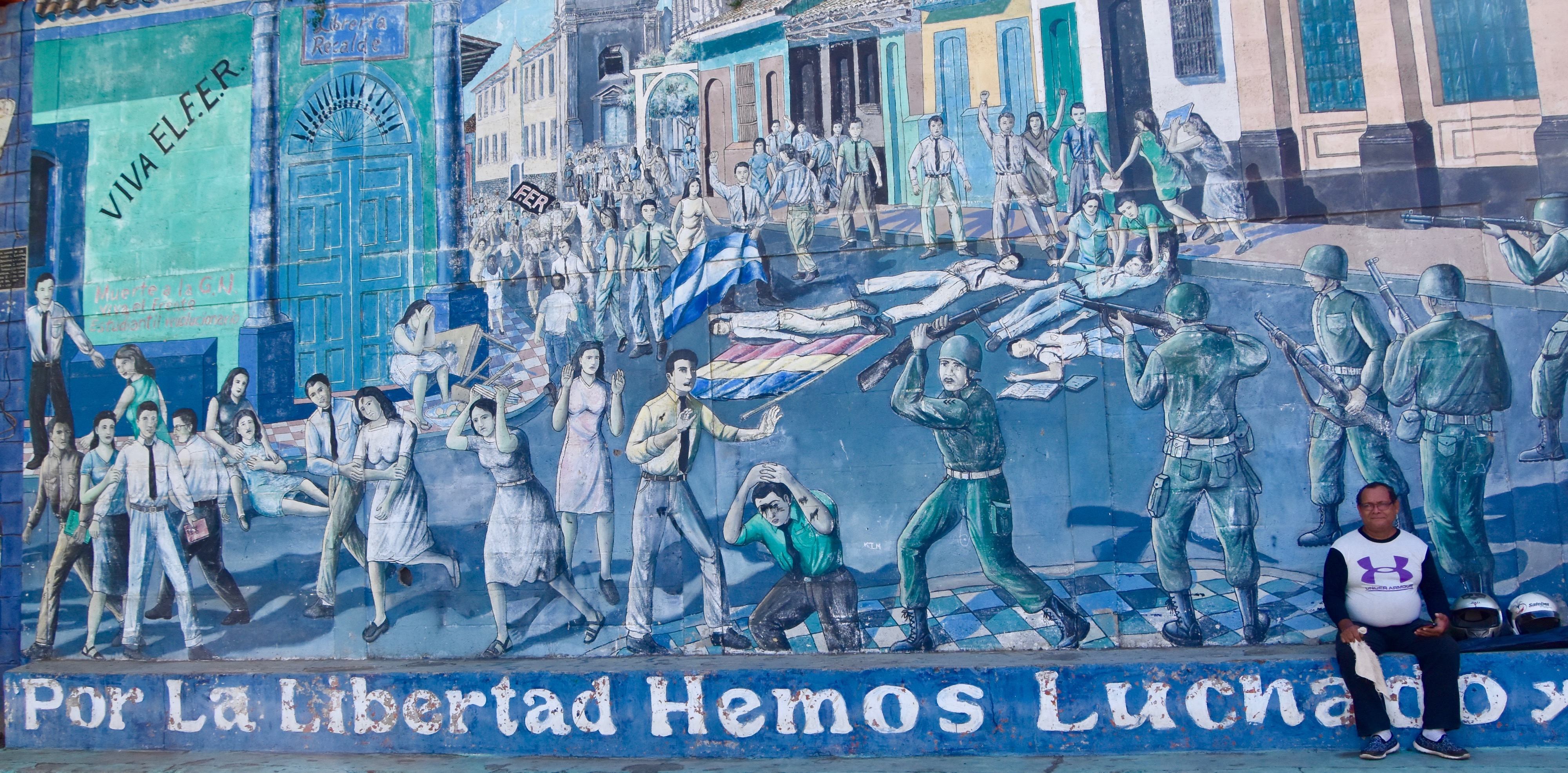
Leon is a university town with all that entails, which usually means a liberal, artsy and sometimes revolutionary fervor coupled with the vibrancy of youth. National Autonomous University of Nicaragua (UNAN) is the second oldest in Central America and has been the hotbed of many left of centre groups including the Sandinistas as we shall see on our city tour. It was also the home of Rubén Darío, Nicaragua’s revered national poet and many other notable literary figures. Where Granada is staid, Leon feels the opposite and that has been the case for centuries. Leon was the original capitol, but it yoyoed back and forth with Granada depending upon whether a right wing administration in the case of Granada or a left wing in the case of Leon, was in power. It was only settled by compromising on Managua in 1852.
Today Leon is the second largest city in Nicaragua with a population of just over 200,000. It’s rivalry with Granada is now more to see who can attract the most tourists and both are losing at that game, at least for now. Maybe more posts like this will change people’s minds about visiting these cities.
Hotel El Convento
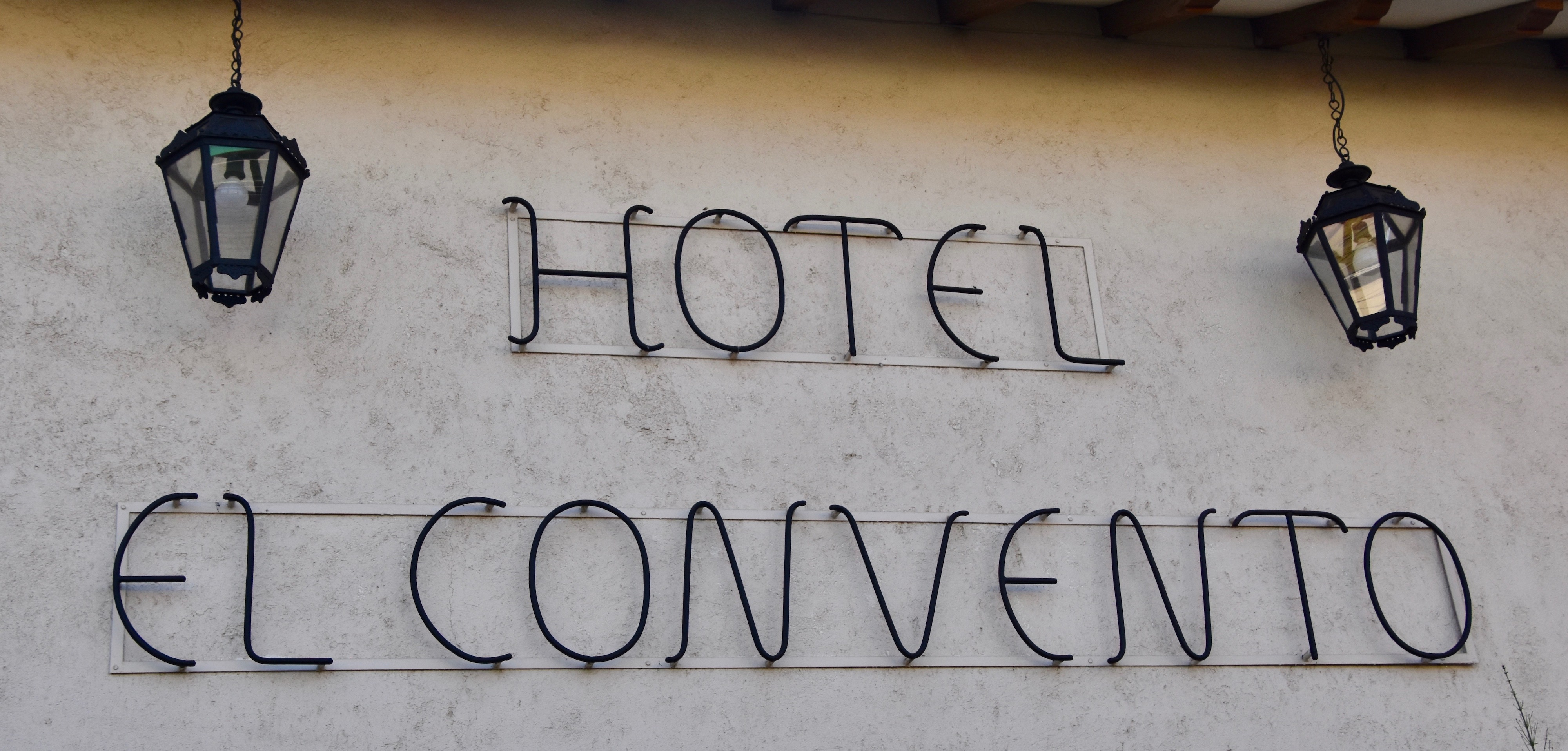
It sure didn’t hurt my impression of Leon that we stayed in an absolutely gem of a hotel while we were there. As you can guess from the name Hotel El Convento was once a convent, although that word can mean what we would consider a monastery as well. The San Francisco Convent dates all the way back to 1639 and was run by the Franciscans until they were expelled from Nicaragua in 1829. After that it has served as a school, an institution of higher learning, a convent once again, but with sisters this time and lastly a school once again. Damaged by earthquakes and then bombed into oblivion during the civil war, by 1980 there was nothing left of the original historic structure.
Beginning in 1995, the site was purchased by the current owner who obtained as many plans as he could assemble to build a hotel that was as close in design to the original convent as possible. He has succeeded spectacularly. I had no idea until I began my research for this post that the place was essentially new. Other than the fan, does this look 21st century to you?

The place is absolutely loaded with great pieces of art, most religious in nature, but not your run of the mill stiff depictions of saints and madonnas. For example take this angel with the Dolly Partonesque superstructure and the children all waiting their turn. I’ve seen lots of angels, but never one that looked like this.
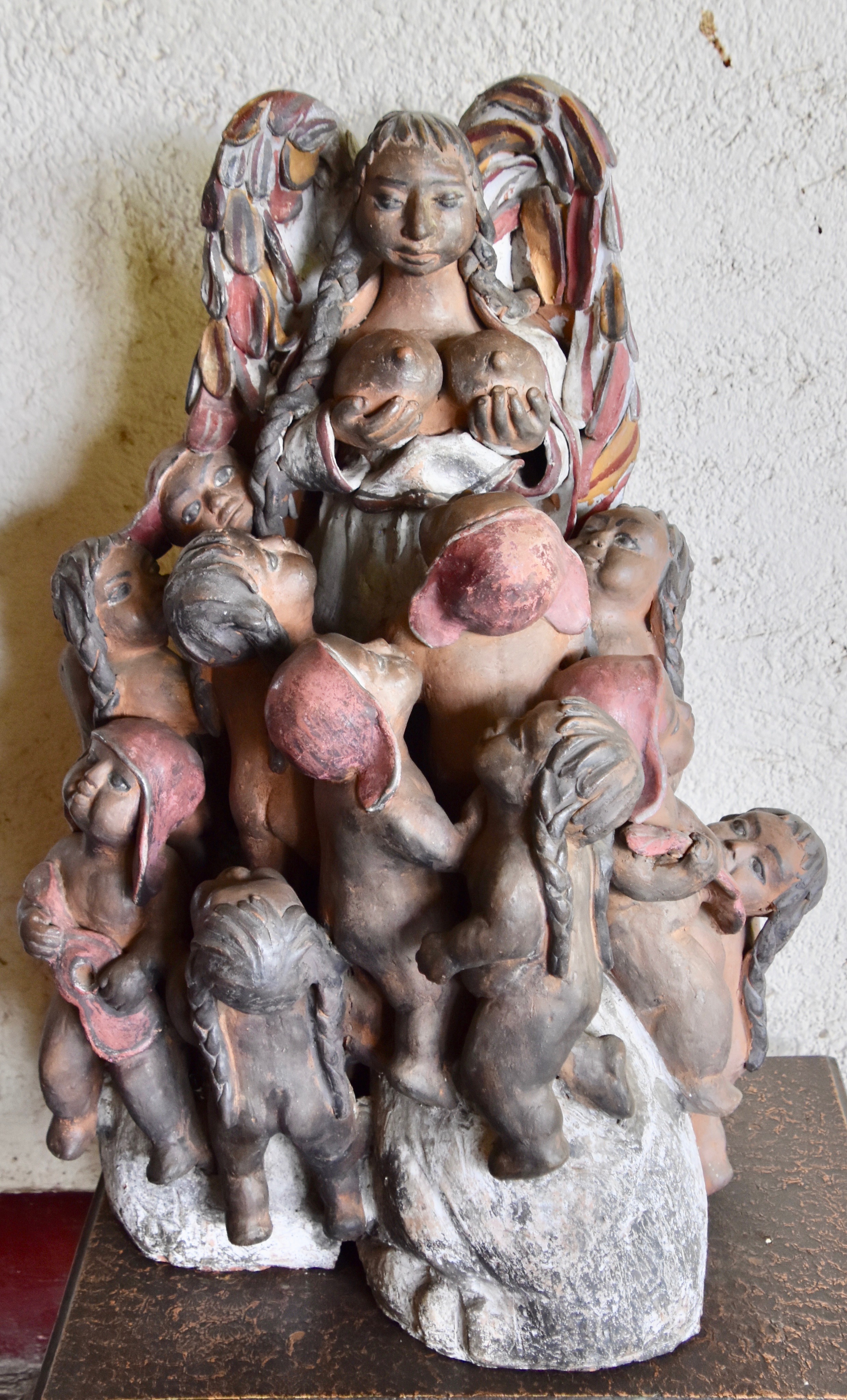
Here is another example. This mannequin like figure is praying, but the look is so abject that it comes across more as pleading.
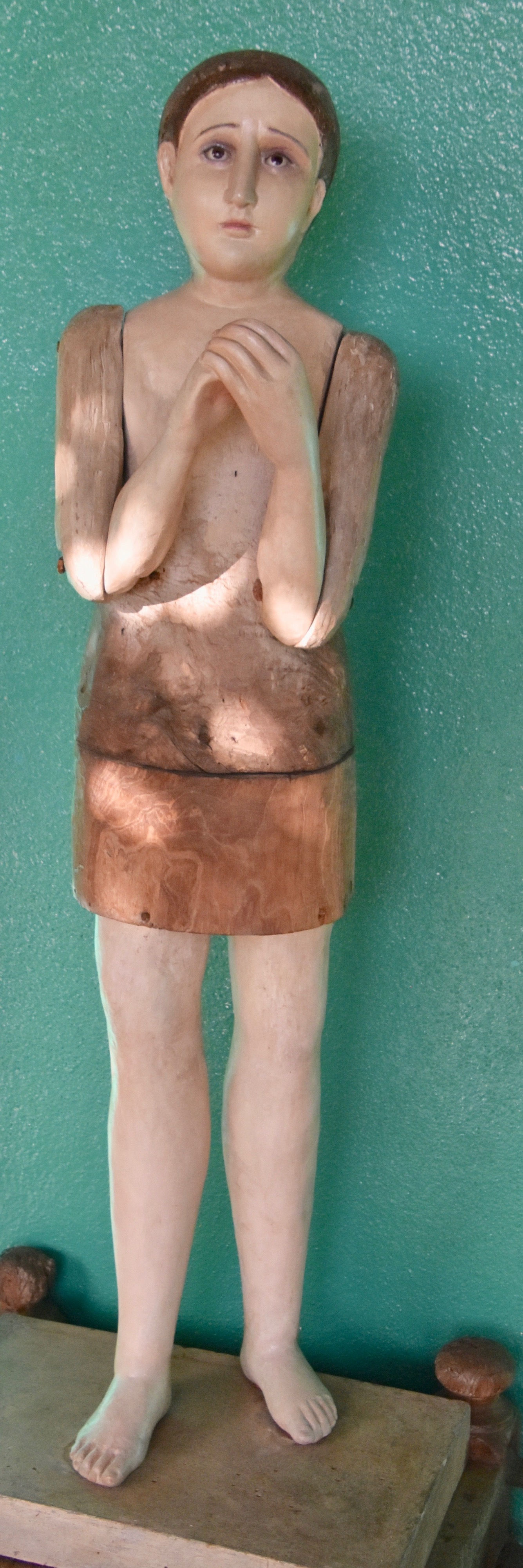
One more. There were a number of these half figures that I presume would have been attached to legs at one point. There is a lonely vacancy to the eyes that is eerily captivating.
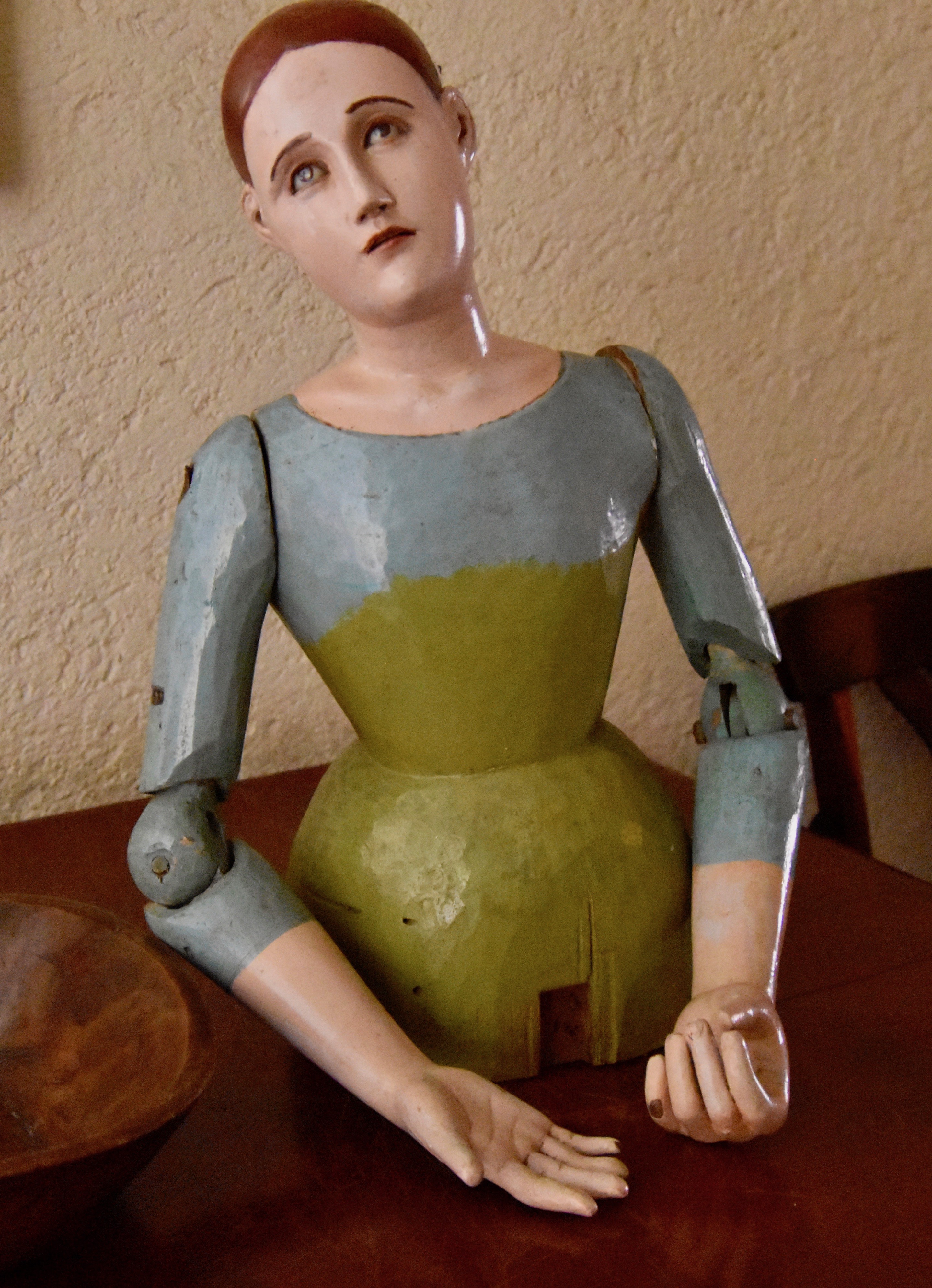
And it’s not just older pieces on display. There are a number of modern paintings including this one, but the faces have the same wistful look as the two above.

Aside from looking at the art there is also a nice courtyard and fountain that was a favourite gathering spot for white-winged doves in the early morning and at evening. They are as ubiquitous in Leon as our rock doves aka pigeons are at home and just as horny. The gatherings tended to resemble an avian orgy, but they did sound nice.

The rooms were spacious with brick walls and tile floors that kept the rooms cool although there was also air conditioning if you wanted it, but we generally found the ambient temperature just right.
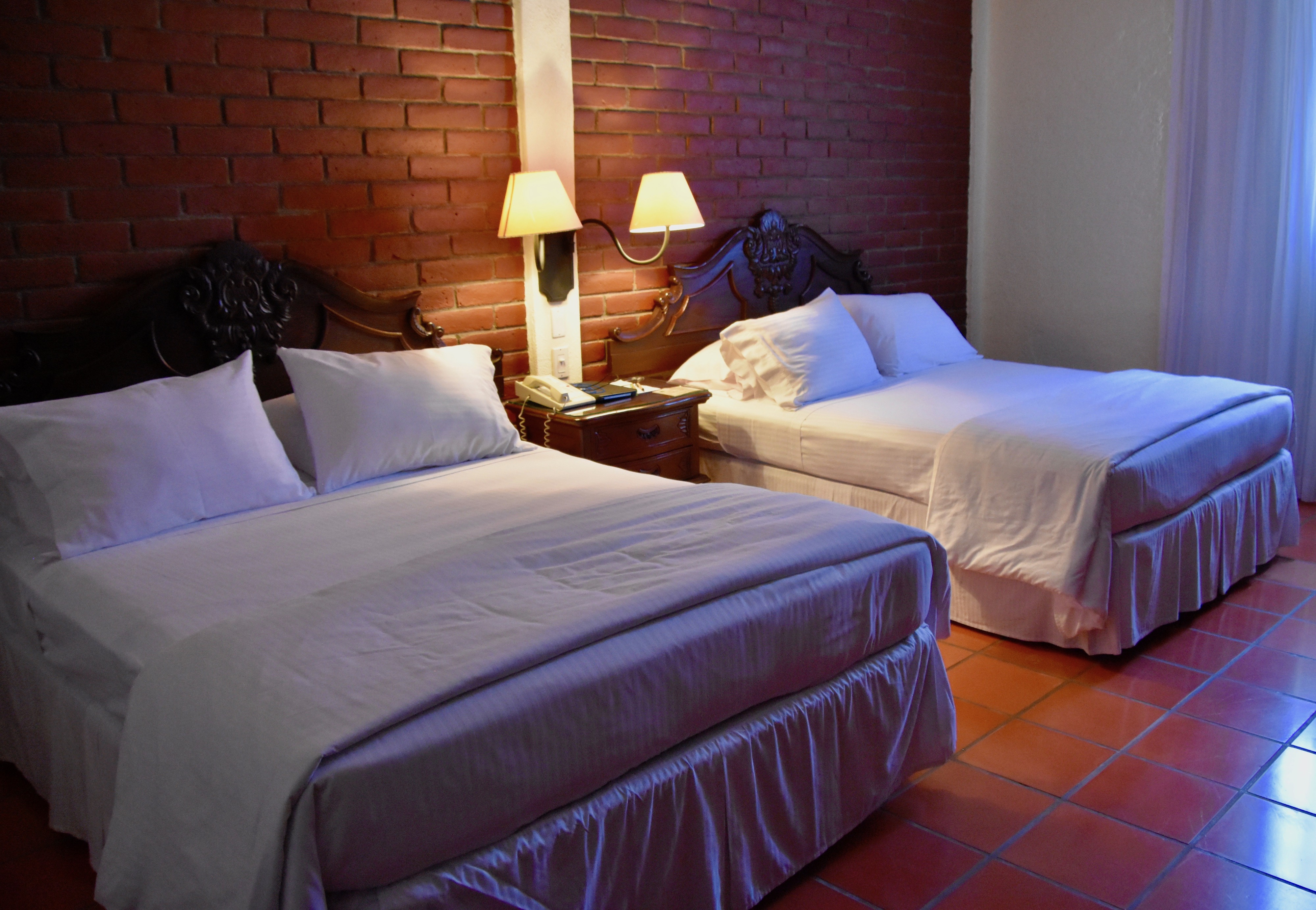
Victor outdid himself in choosing Hotel El Convento for our stay in Leon. Not only was the hotel itself great, but the location was excellent. It seemed that almost everything you would want to see was only a few blocks away in one direction or another.
Leon is laid out in a grid and is pretty flat so the walking was easy. Using the map given out by the hotel, only an idiot could get lost and it felt perfectly safe at all times. As noted the vibe on the streets was much more lively than Granada and despite being full of university students, there was not the constant smell of urine that we found in that city. With those thoughts in mind, let’s go exploring.
Church of St. Francis
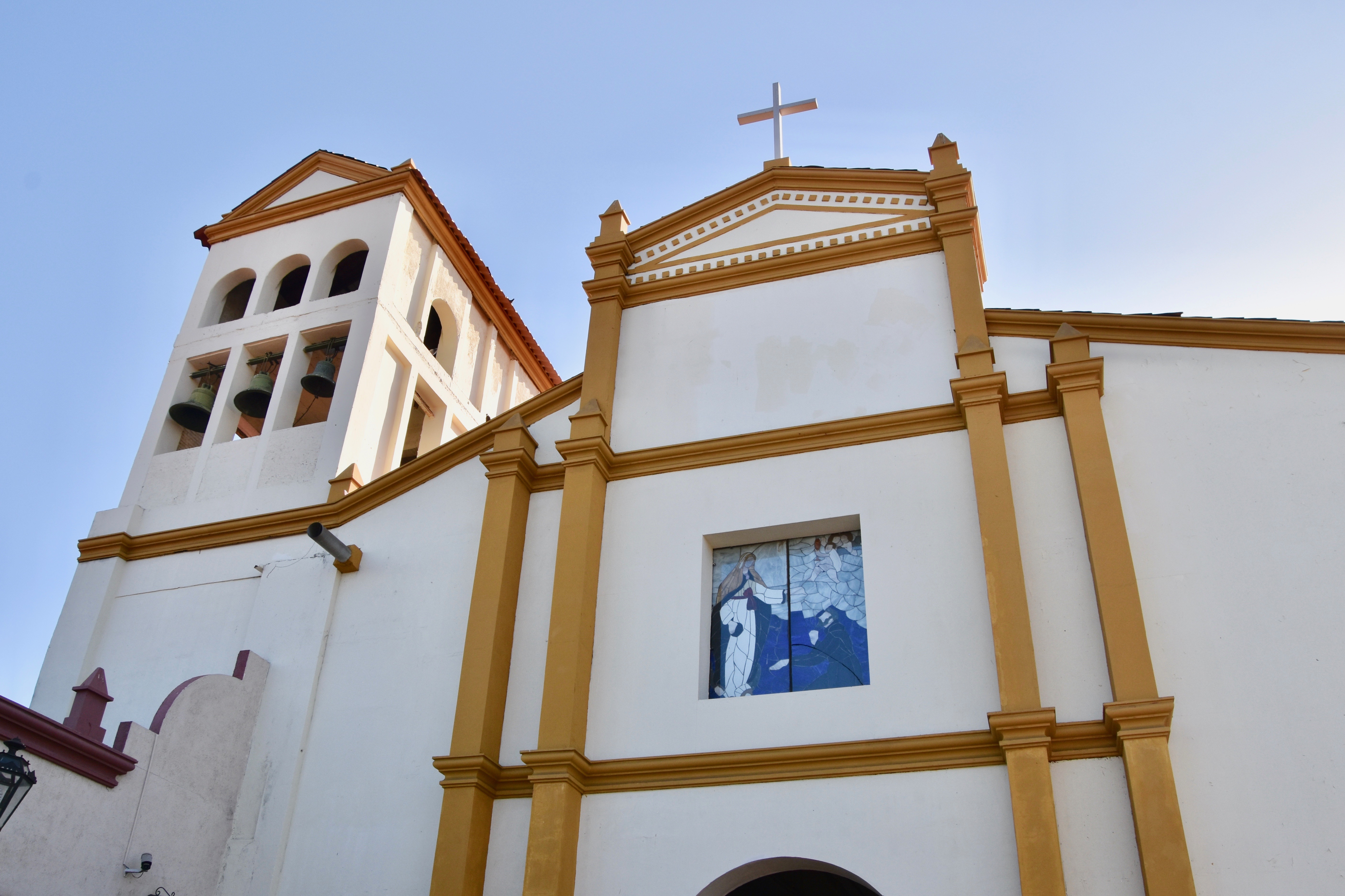
Literally right beside Hotel El Convento is the Church of St. Francis whose origins date back to 1639 and was the church where the brothers and later sisters from the convent took their services. Unlike the convent, it apparently was never totally demolished during the many revolutions that plagued Leon, although its facade has had a number of redos. The current version with use of wood and plaster and singular bell tower is quite fetching.
On the forecourt is this modern statue showing the parable of St. Francis and the Wolf of Gubbio which is also appealing. St. Francis gained his reputation for having control over animals when he persuaded this man-eating wolf to convert to eating more conventional food and become a sort of mascot for the town. So next time you are confronted by a man-eating beast simply invoke a prayer to St. Francis, or run like hell.
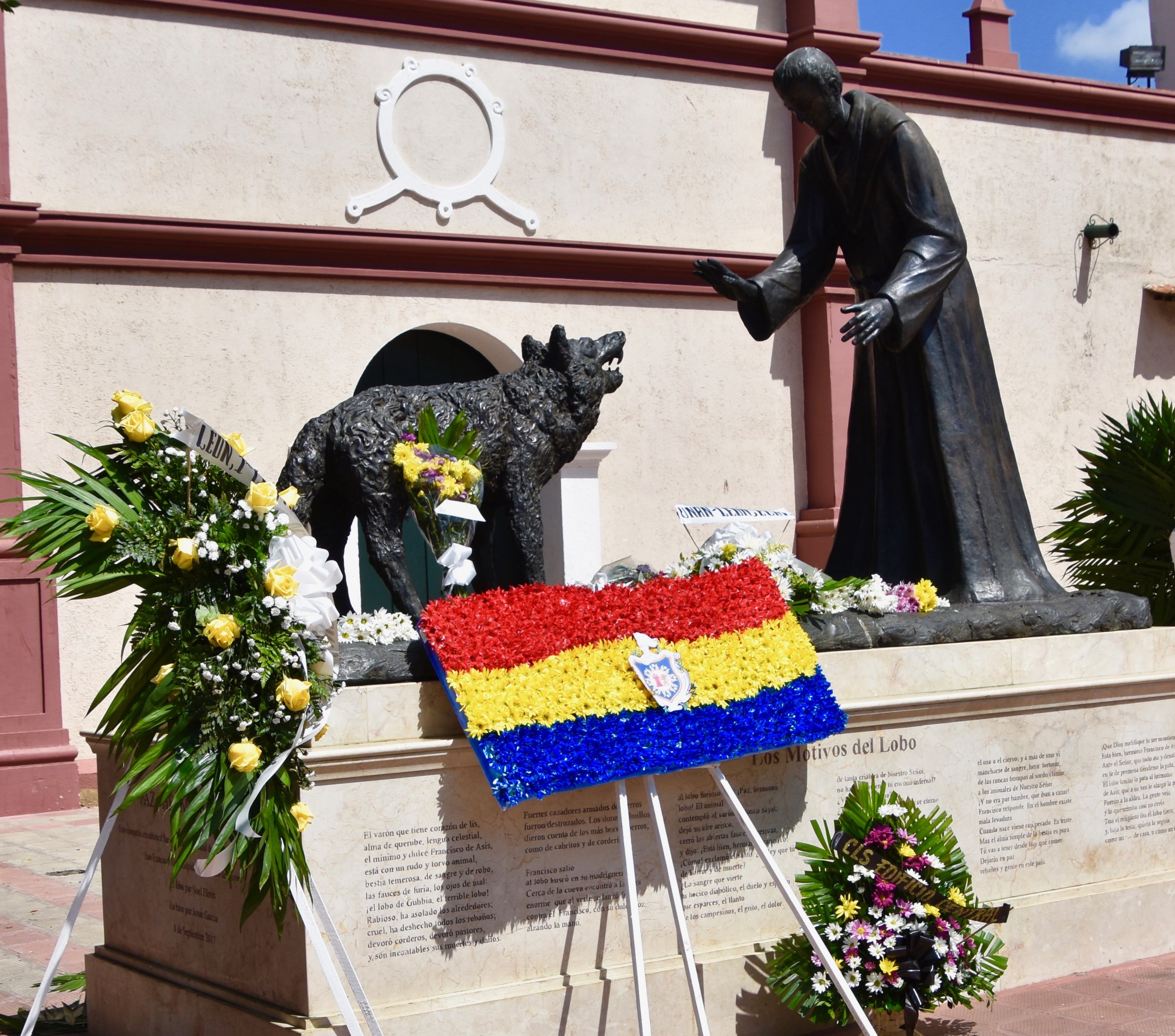
I don’t know if Victor planned our visit to Leon to coincide with Rubén Dario day or not, but the fact was we were here on the day set aside to honour Nicaragua’s national poet and a revered figure throughout Latin America. There will be much more about him as we tour Leon, but for now the reason that the flowers have been placed here is that Dario wrote Los Motivos del Lobo (The Motives of the Wolf) which tells the story from the wolf’s perspective. The flowers were put here by members of the Sandanista party, more of whom we’ll also see later on this tour. Unlike most Communist or near Communist regimes, the Sandanistas embrace religion which is kind of strange because the Catholic Church has never historically been on the side of commoner.
There are some interesting things inside the church as well as outside. This is San Benito aka Benedict the Moor a patron saint of African Americans and widely venerated for his healing abilities. Note that his skirt is covered with small images, mostly of babies, that have been pinned to the garment in the hopes that he will cure whatever is ailing their child.
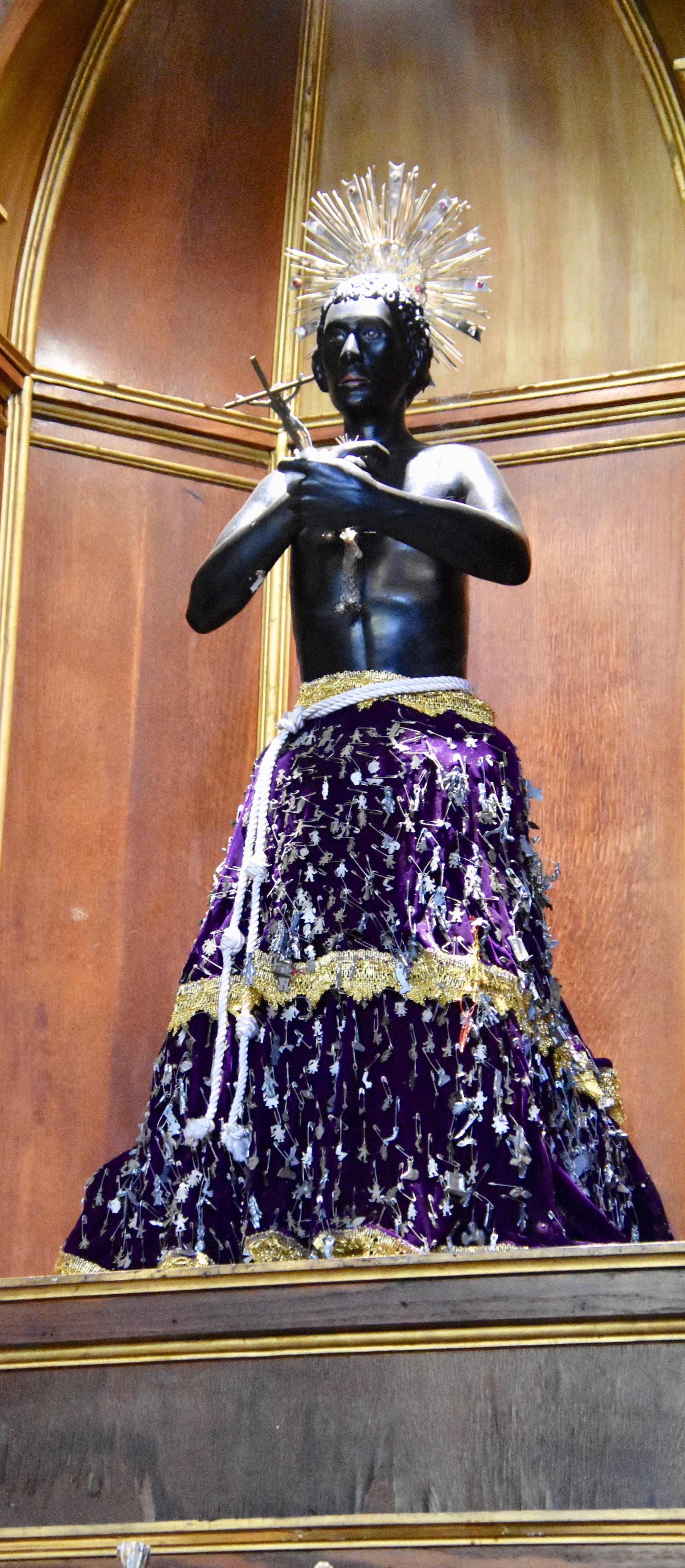
People don’t just come to this church to prayer for a cure. Some come to pray for a house. Really. Here our Nicaraguan guide Aura Munguia, explains that couples hoping to be able to buy a home come here to pray before the Virgin Mary and leave a token house behind. That, combined with having the asking price, will do the trick every time.
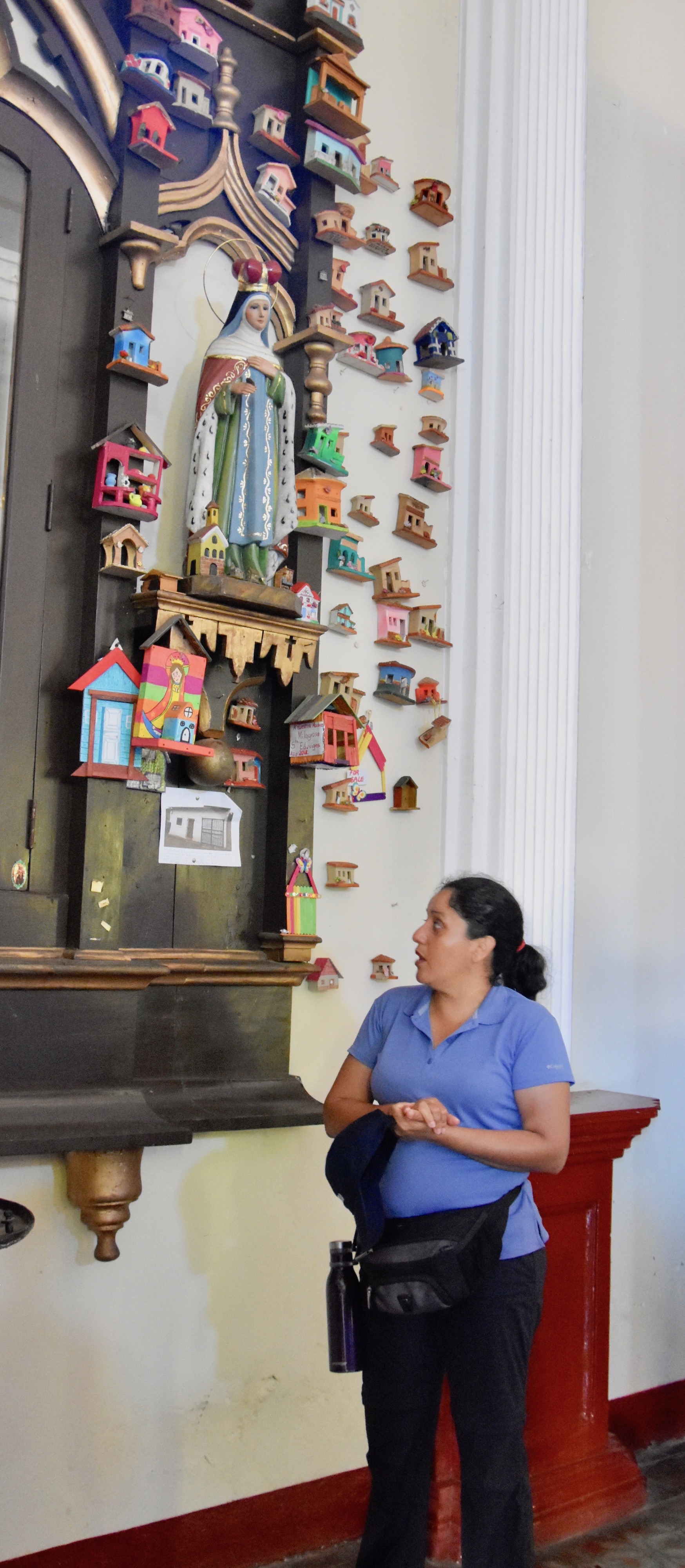
This is a replica of the Black Virgin of Montserrat, the original being in a monastery in Montserrat, Spain. We saw another version high above the city of Bogota, Colombia on an Adventures Abroad trip a couple of years ago.
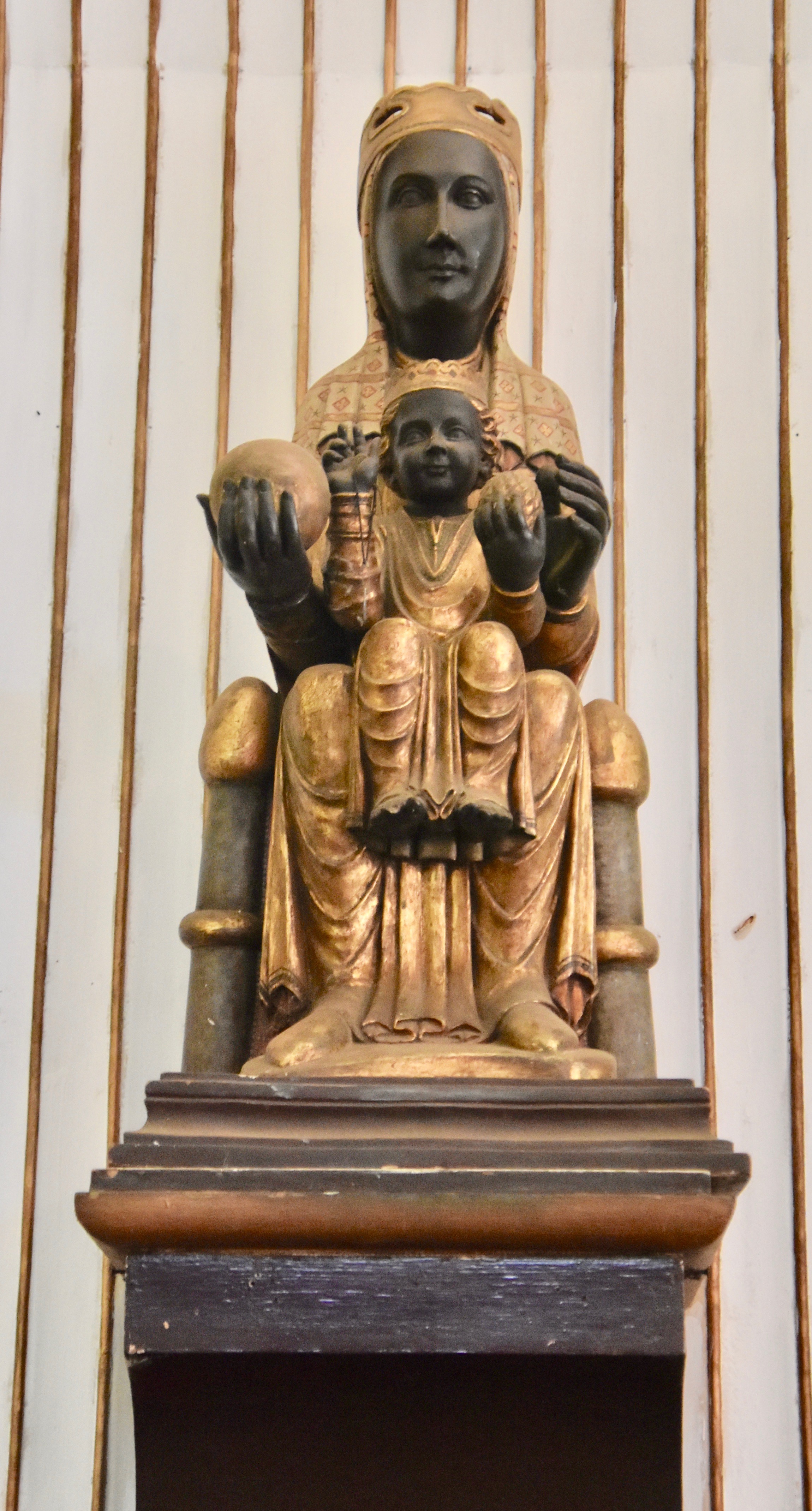
Moving on just a block or so away is Nicaragua’s version of Poet’s Corner where this statue of Rubén Dario dominates a small plaza.
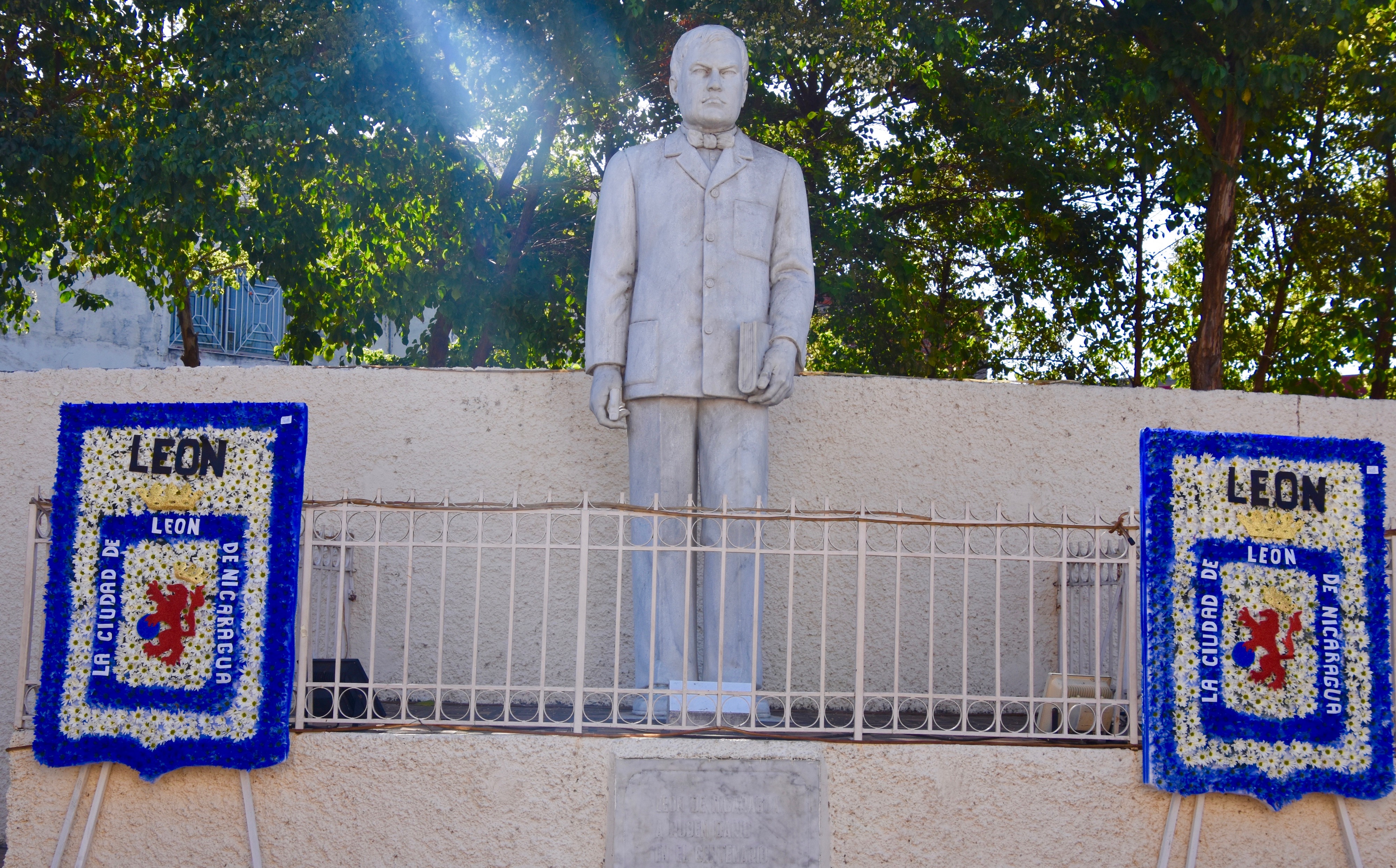
During his life he travelled widely throughout Latin America, United States and Europe and gained celebrity as a writer and journalist wherever he went. He is probably the man that most Nicaraguans admire the most and certainly the natives of Leon. Once again the Sandanistas have beat us here, putting up the flag of the city in flowers on this special day.
The house where Rubén Dario spent much of his time in Leon and where he died in 1916 is quite close by and is now a museum. We did have a tour, but they don’t allow photos and with almost all the exhibits only with Spanish descriptions, I can’t say that I developed a feel for this man who is second only to Sandino in terms of seeing his image everywhere in the city.
Speaking of Sandino, let’s talk some politics.
The Sandanista Murals
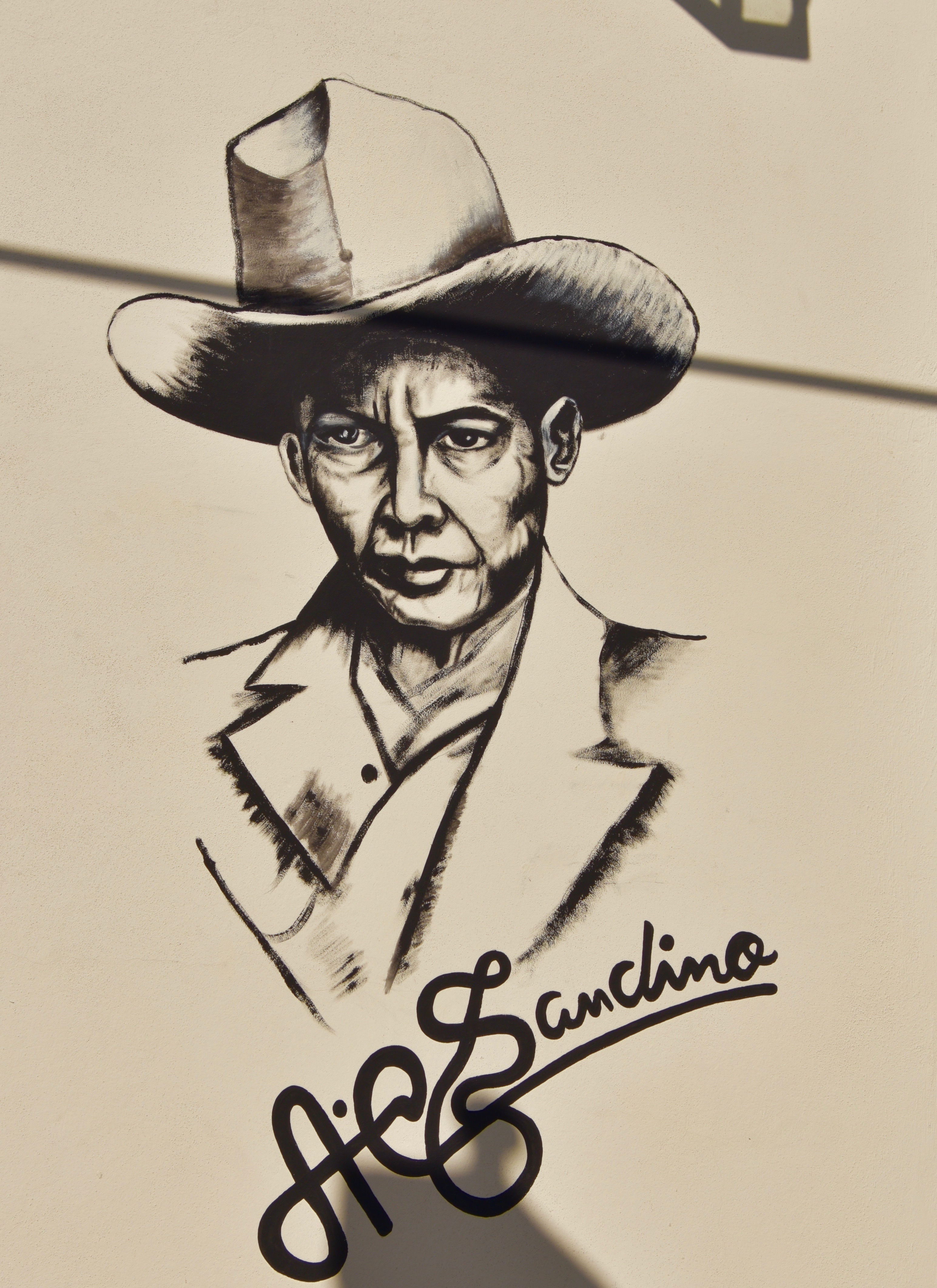
Augusto César Sandino is unquestionably Nicaragua’s national hero, at least when the Sandanistas are in power. His efforts to fight the foreign intervention by the United States Marines from 1927 to 1933 are the stuff of legend, even though he ultimately failed and was assassinated by the first of the Somozas who subsequently ruled the country for forty years. The organization that eventually deposed the Somoza regime was named for Sandino so you could say that in the long run he did triumph although perhaps not in the way he would have liked.
Here are a couple of murals depicting Sandino crushing both the Somoza regime, depicted as a dog and the United States, depicted as Uncle Sam.
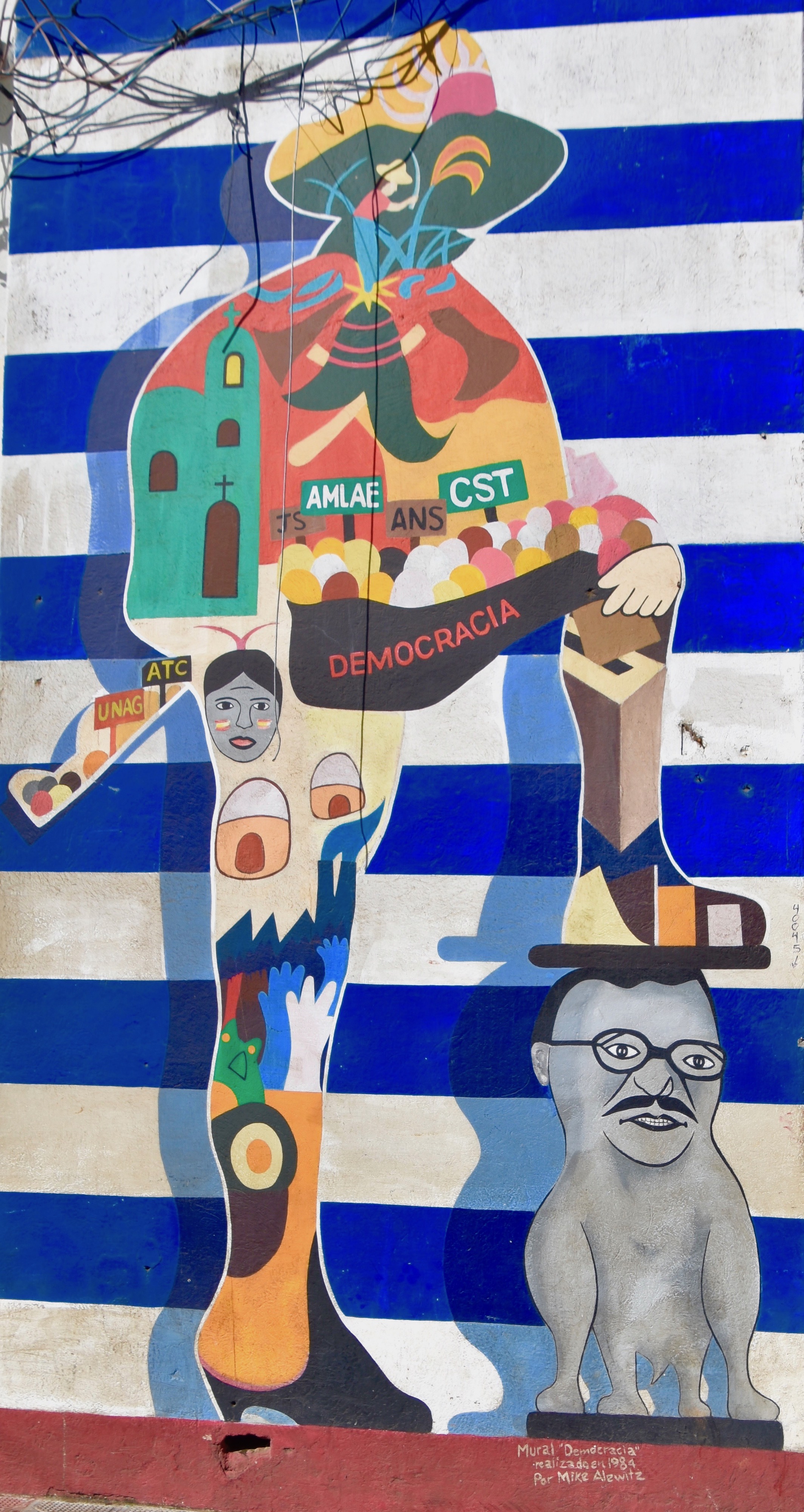
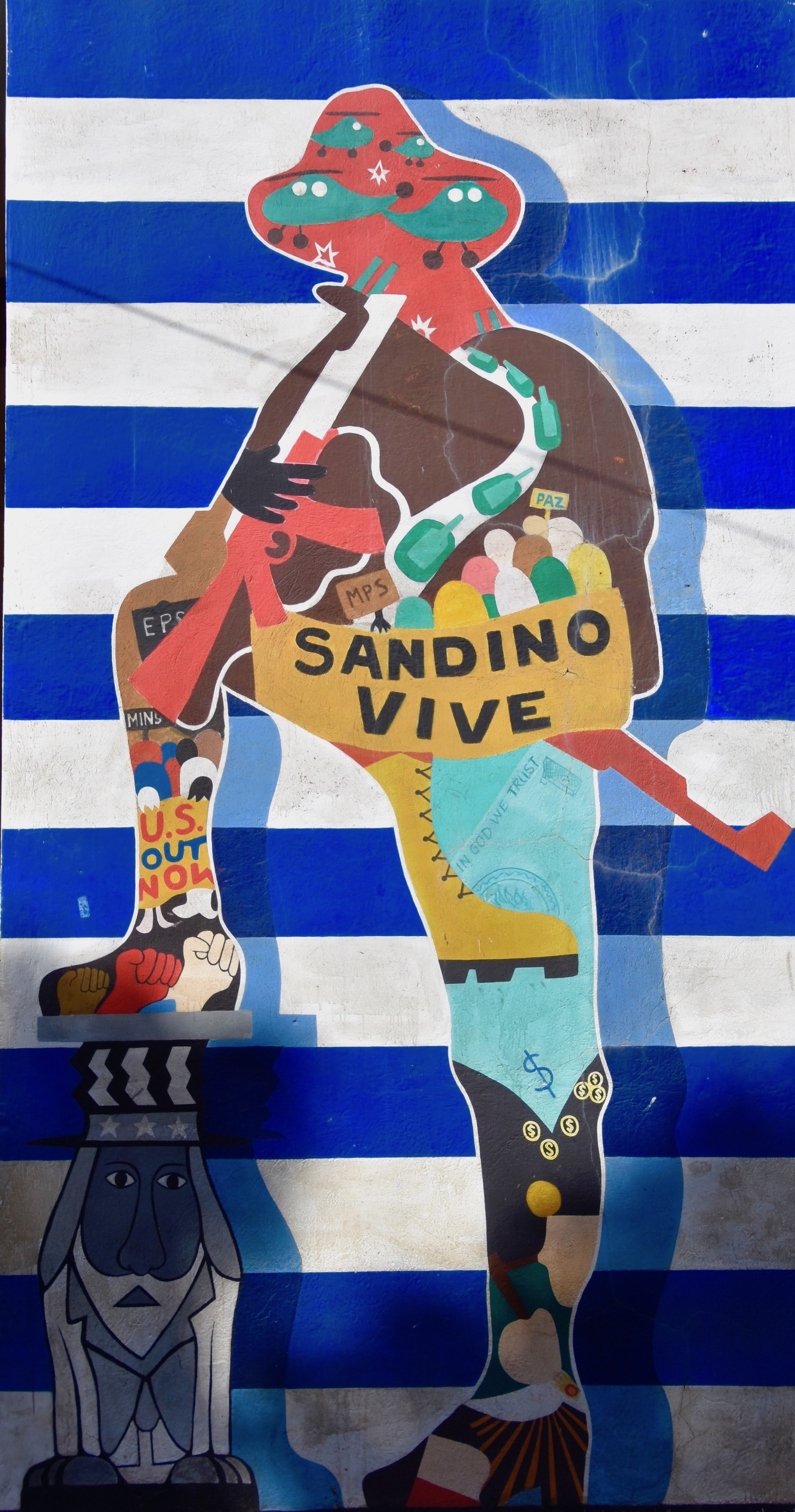
These and other murals are found in the university district including a number to the four martyrs and Carlos Fonseca, the founder of the Sandanistas who was a student at the university in Leon. In 1959, inspired by Castro’s successful revolution in Cuba he started a guerrilla war that lasted off and on until he was killed in 1976, three years before the Sandanistas finally prevailed. The four martyrs were students at the Leon university who were shot dead by Somoza forces during protests in 1959. The photo at the top of this post shows that event in the very spot where it happened.
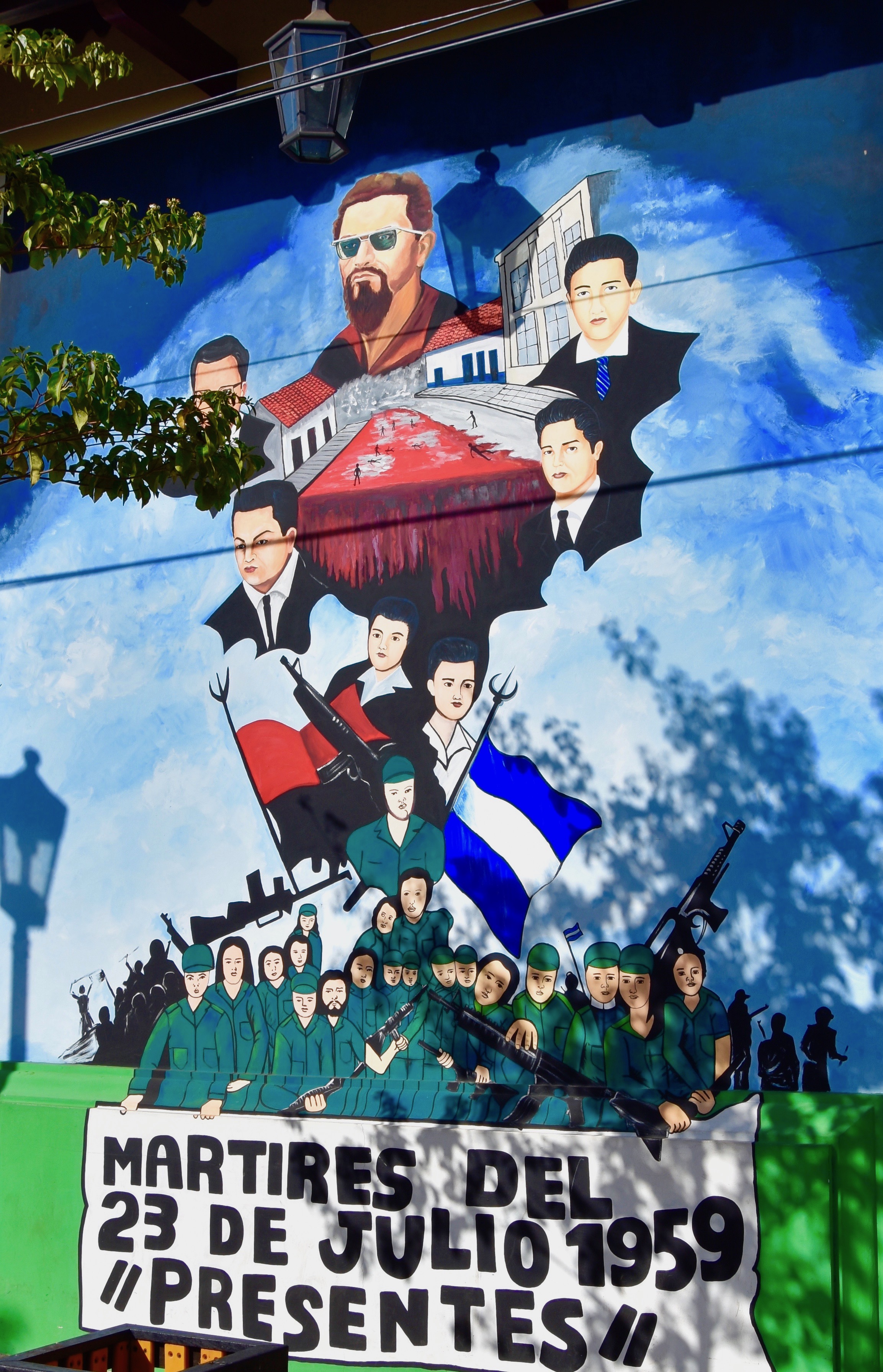
Here’s the thing – the Sandanistas today are every bit as corrupt and thuggish as their predecessors. While Daniel Ortega might originally have been a man of the people that long ago evaporated with the irresistible taste of power. In 2018 protests broke out across the country with the students of Leon now once again calling for the end of a dictatorship. The Sandanista response was brutal. Over 350 people were killed over the ensuing months until, with the alleged help of Cuban and Venezuelan ‘advisors’ order was restored. Today there is no trace of any recognition that the regime that canonizes four students killed in 1959, killed almost a hundred times as many just two years ago.
No doubt when the Sandanista regime falls, and at some point it will, the murals we saw today will be painted over with ones depicting the events of 2018.
OK, enough about politics, let’s go back to church.
Leon Cathedral
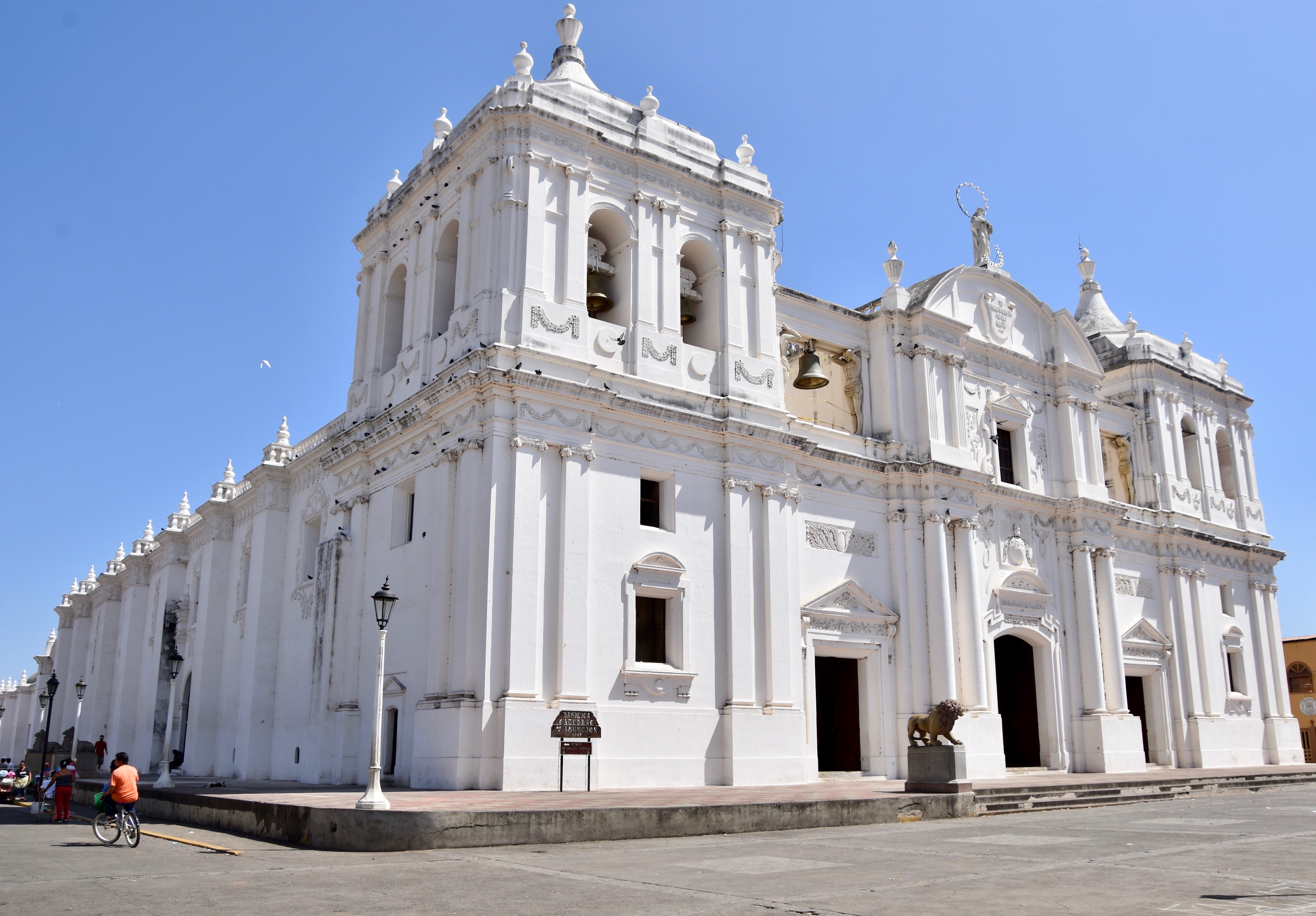
The Cathedral of the Assumption of Mary or for simplicity, just Leon cathedral is supposedly the largest in Central America, but I suspect the new one we visited a few days before in Managua holds more people. In any event, this one is a hell of a lot nicer. Older pictures show the exterior as buff coloured sandstone, so the white-washing is relatively recent. Seems appropriate in light of what I just wrote about above.
The cathedral incorporates a number of architectural styles, having been built over a sixty-seven year span between 1747 and 1814. It has a certain squatness to it that has enabled it to withstand the frequent earthquakes that rock the area. Overall, I think it is quite impressive.
Now you wouldn’t know it from the photograph above which I took after our visit, but only a half-hour before we couldn’t get inside because the Sandanista bigwigs were laying wreaths at the tomb of Rubén Dario whose remains are inside. They were friendly enough and after their almost lightning like visit we were duly allowed in to see the great man’s tomb which was now festooned with flowers. For some reason I forgot to take a picture of it.
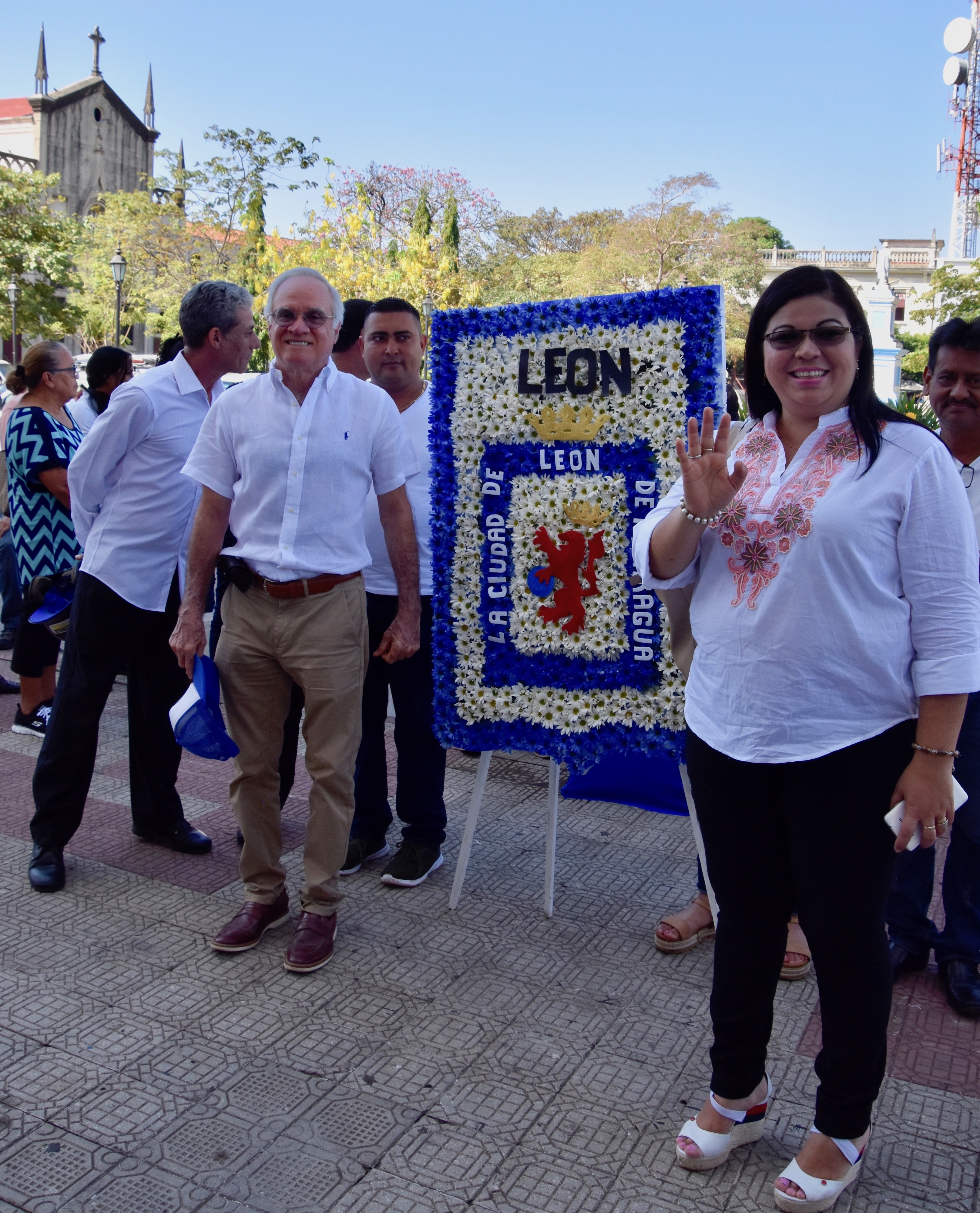
However, the best reason to visit this church is to climb up on the roof and enjoy the view of Leon from up there, including the many volcanoes in the distance.
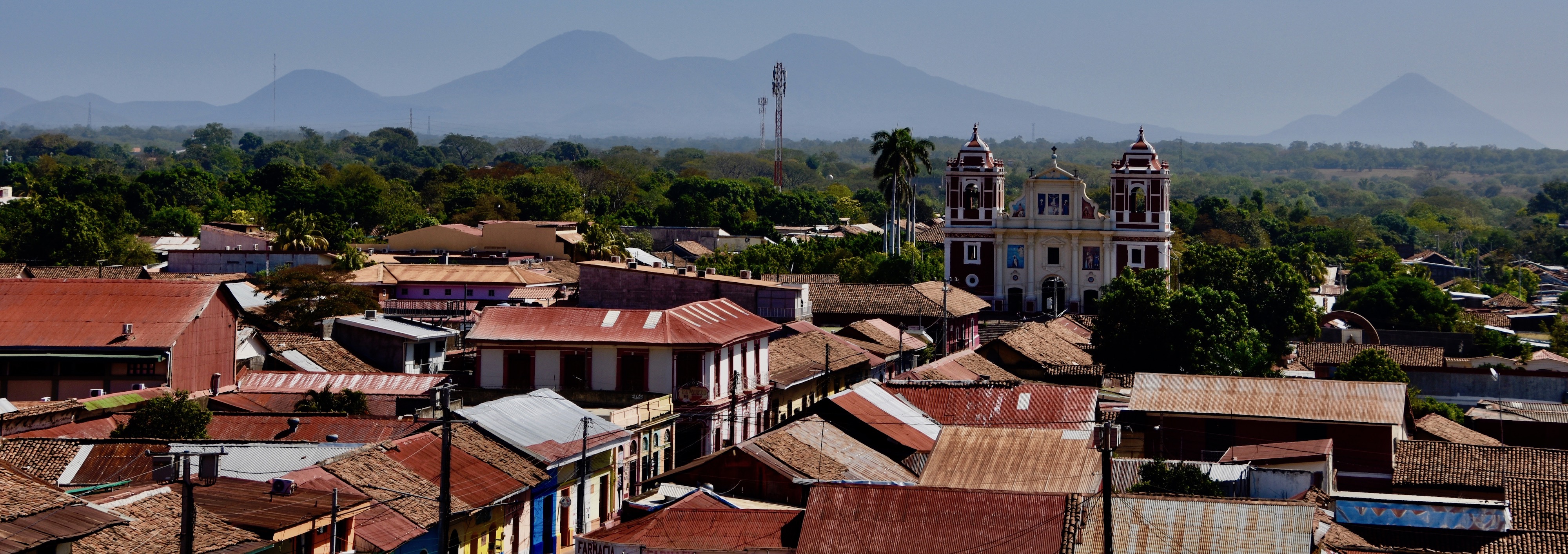
The roof is also painted white and in the bright sun is quite dazzling. This photo Victor took reminded me more of being in Greece than Central America what with the contrast of blue and white that you see in places like Santorini.
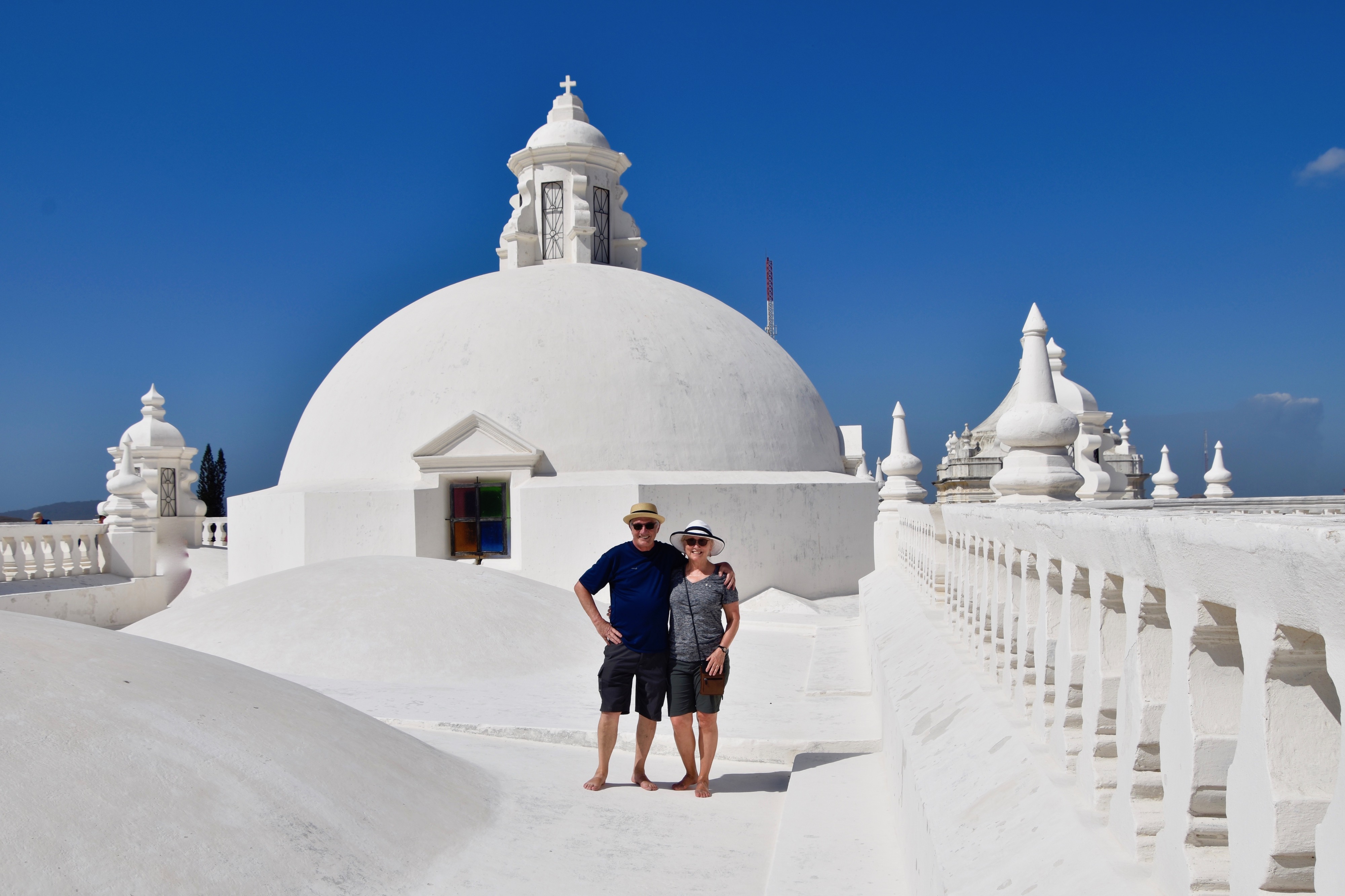
There are two large figures seemingly holding up the ceiling in a Samson like manner from which the bell is attached . They are known simply as the Giants of Leon. Whether that police tape between their legs is going to stop anyone from clambering up or, God forbid, jumping, is debatable.

Back on the ground we were now headed for the Leon market.
Leon Market
So far on this trip we have not visited what I would call a ‘real’ local market. By that I mean one that is there strictly to cater to locals and not tourists. Given that there are virtually no tourists in Nicaragua you would not think that finding a market would be problematic. Yet, the one we did visit in Masaya didn’t seem that authentic or at least what was for sale didn’t. That changed totally today with a visit to Leon market which is one of the most colourful and photographic I’ve seen in many a day.
Let’s start with the produce. Nicaragua grows a tremendous variety of fruits, many of which we never seen in North America. Aura purchased a number of samples of sapodilla, soursop and others I can’t remember and passed them around. Some of these were really tasty and I can only surmise that they don’t travel well or we would see them in North American stores. Another reason to travel.
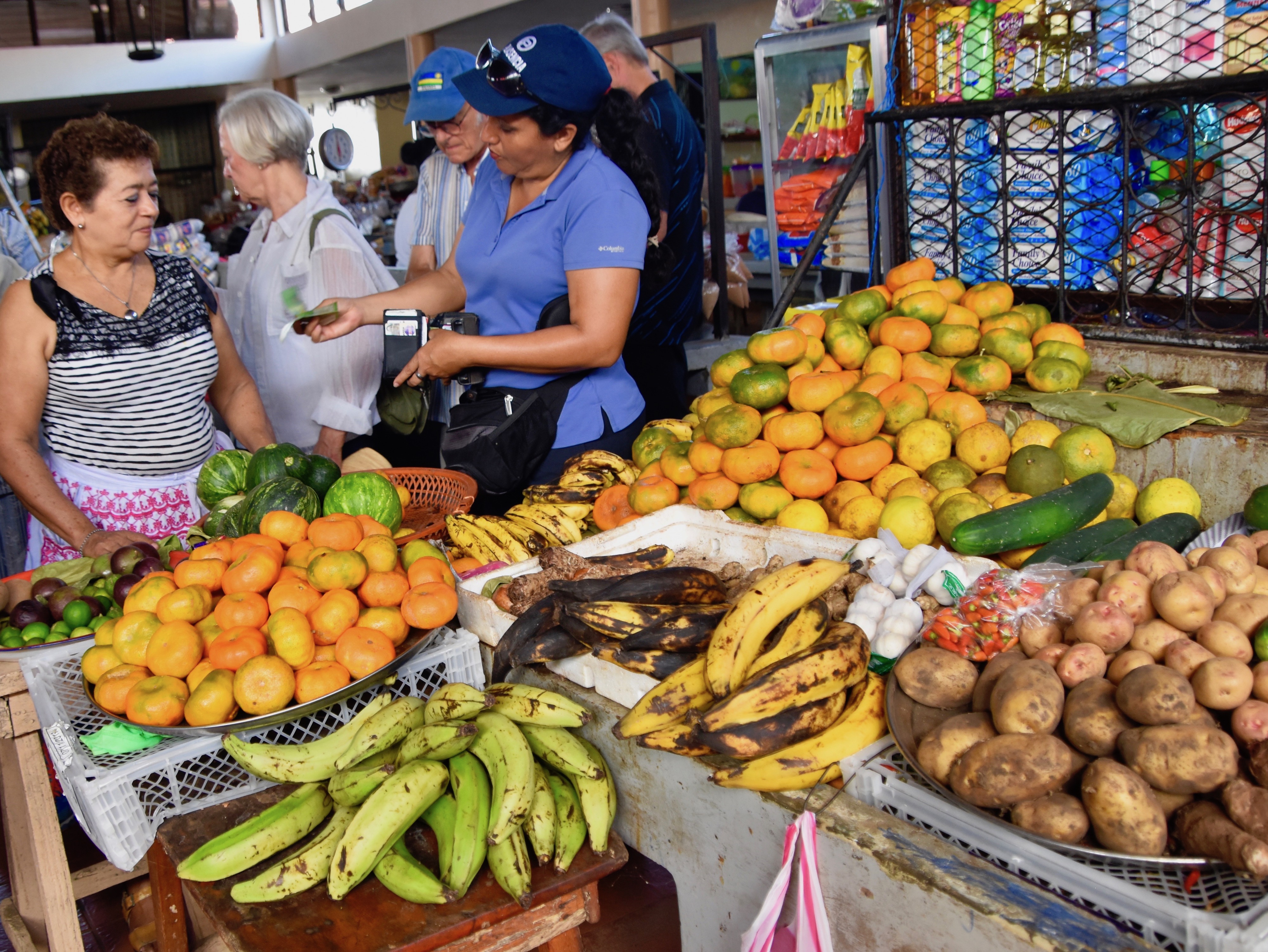
The riot of colour at a fruit and vegetable market makes for endless photo opportunities. Note those avocados that are the size of eggplants.
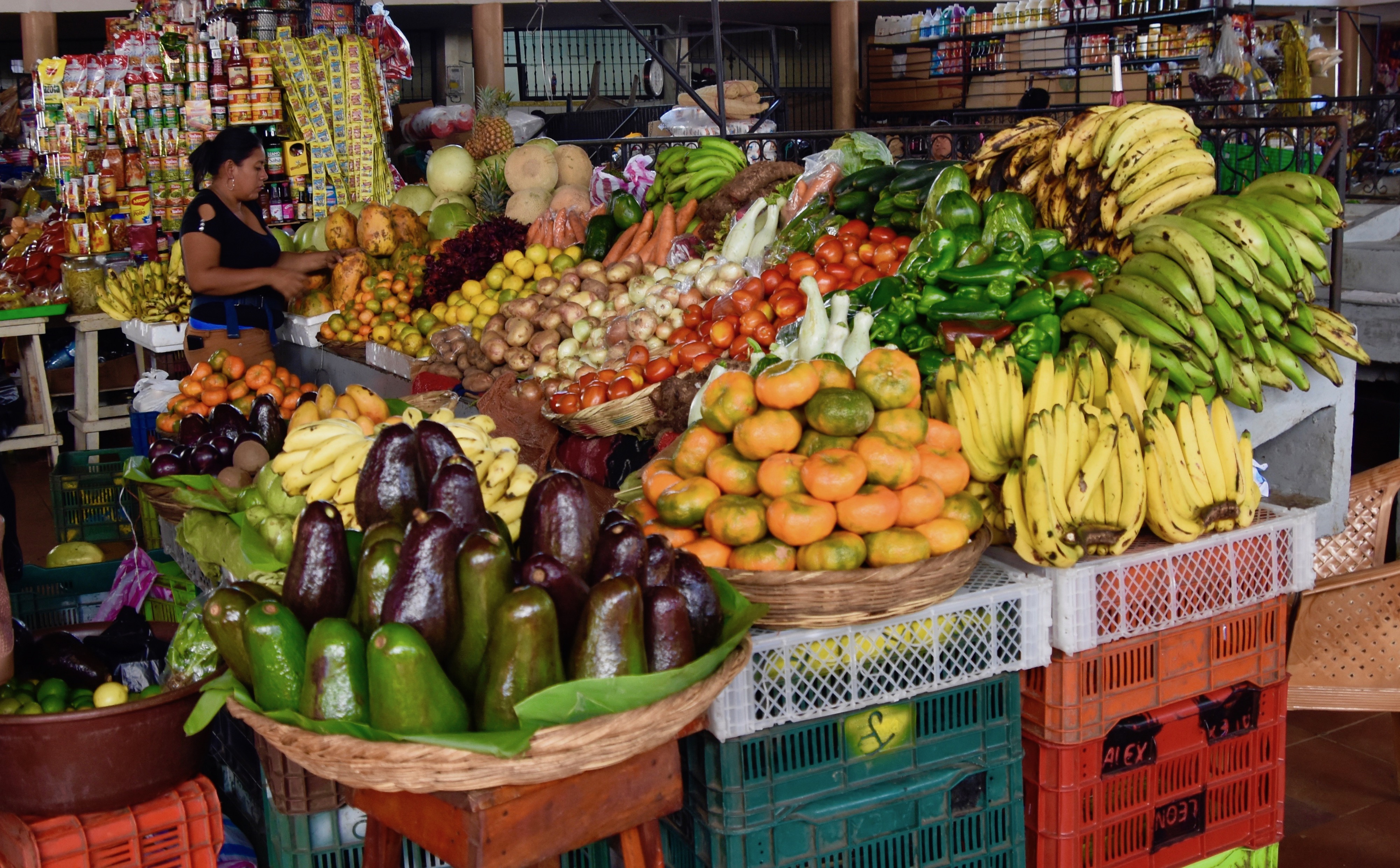
Various types of juices and flavoured drinks are sold throughout Nicaragua in these little plastic bags which unfortunately tend to end up being thrown away, although Leon itself was not litter strewn like parts of the countryside.
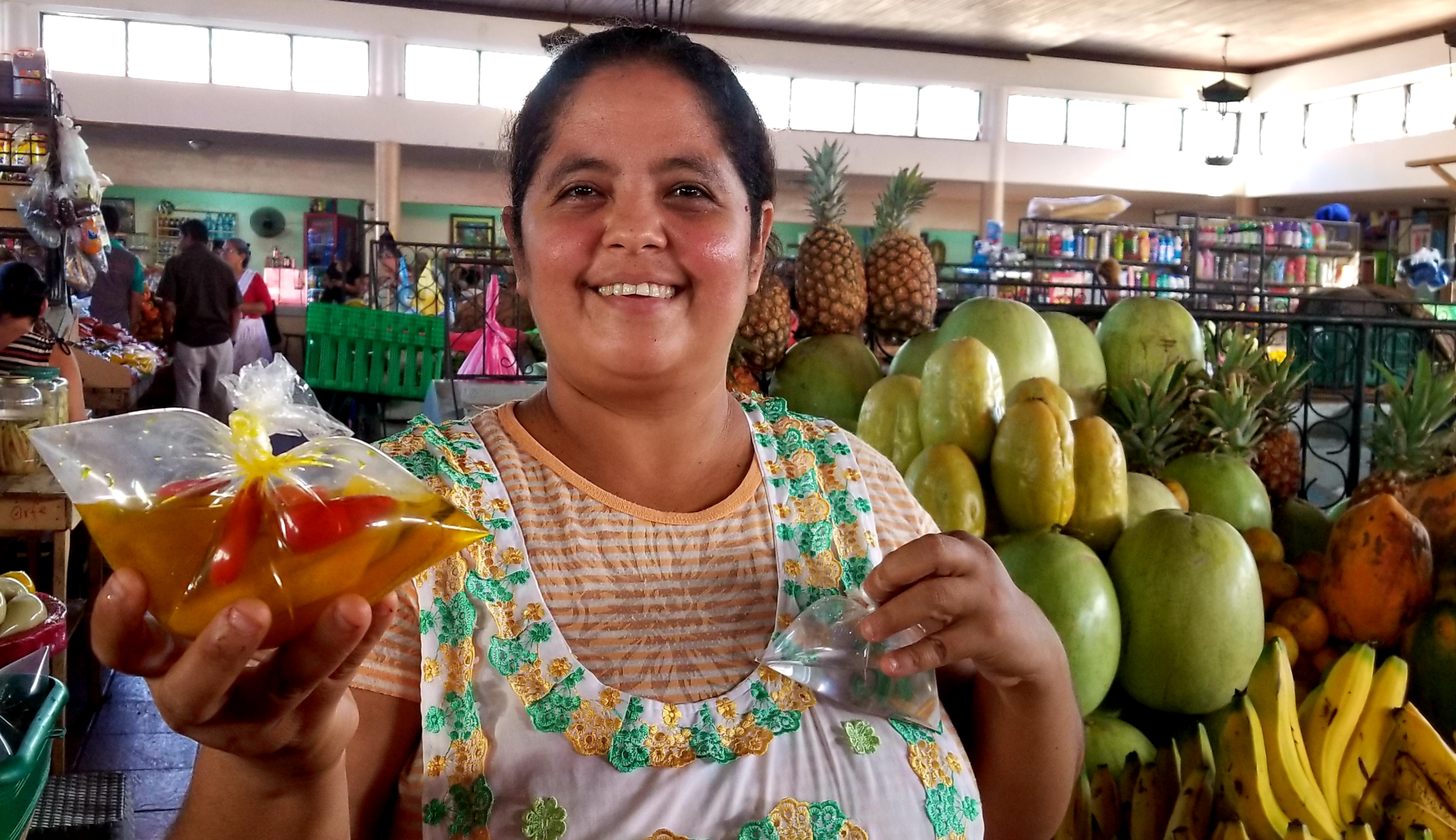
After the fruits and vegetables comes the meat section, not quite like what you see at your local butcher shop.
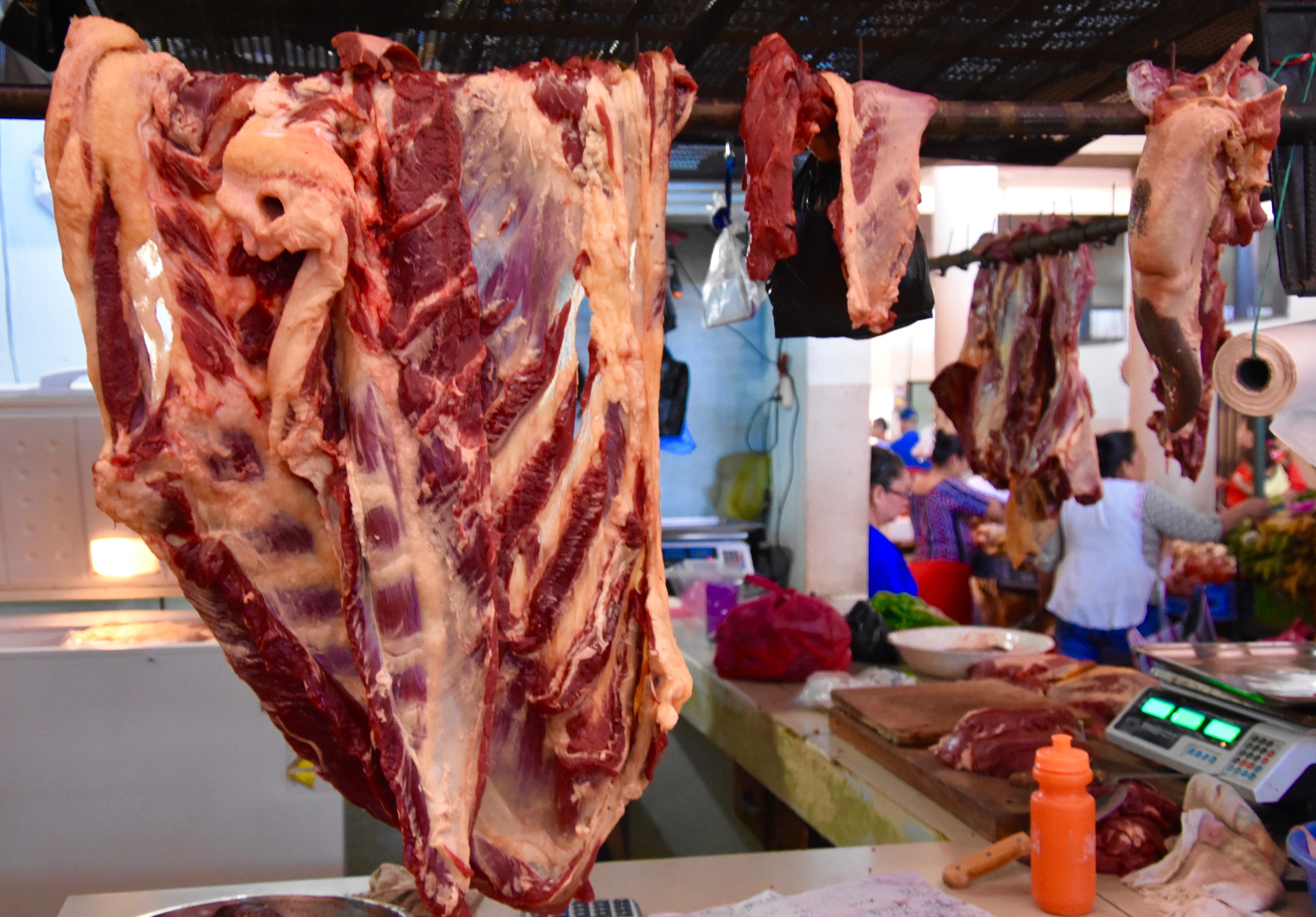
And of course there’s fish, mostly tilapia.

You can always get a hot meal in these markets and it will be much cheaper than in any restaurant.
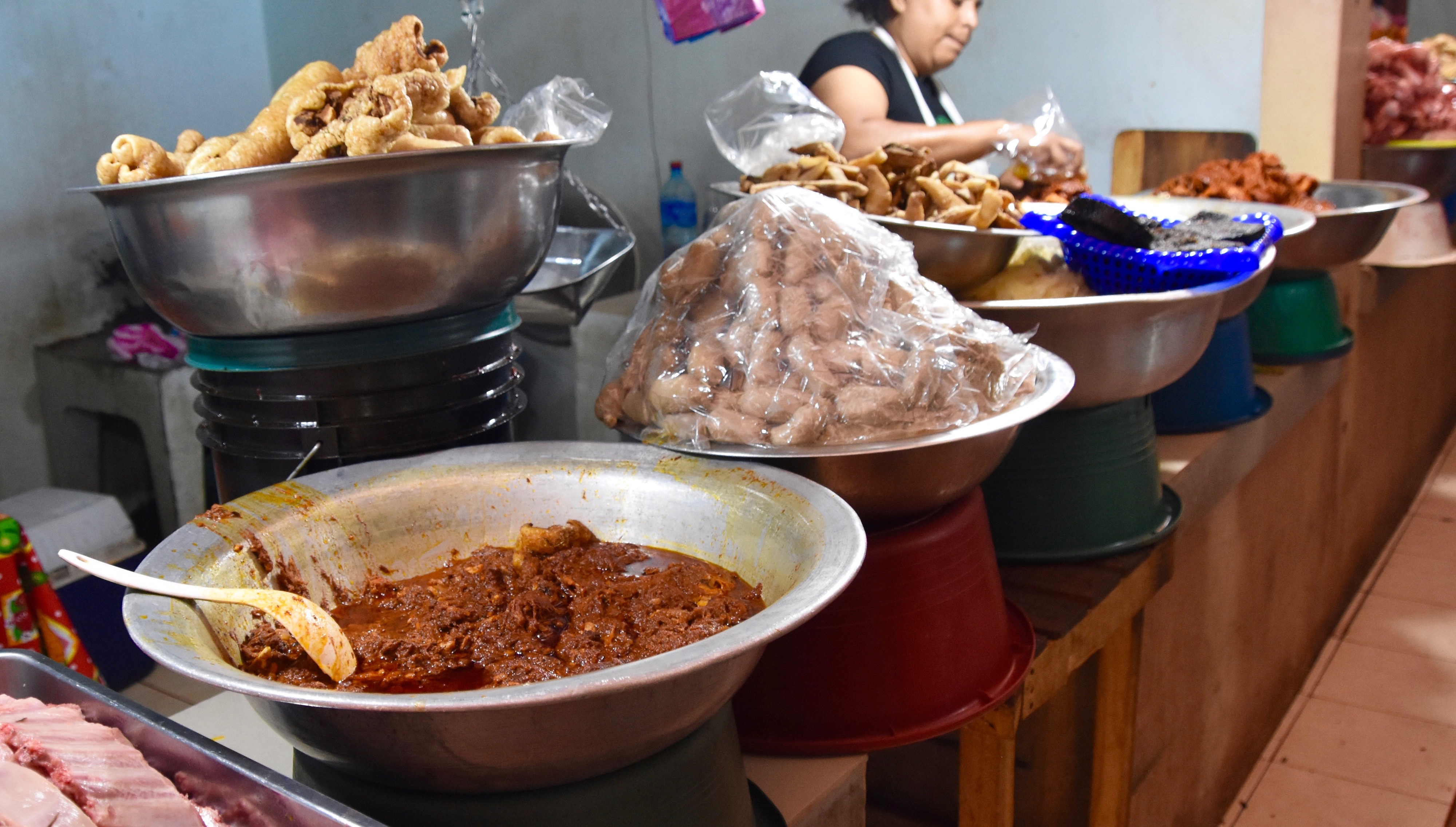
These are real chicharonnes, which are not be confused with pork rinds which are made just from the skin of a pig. Chicharonnes have the skin and the underlying fat which is boiled first and then fried. Some think they are disgusting, but I absolutely love them.
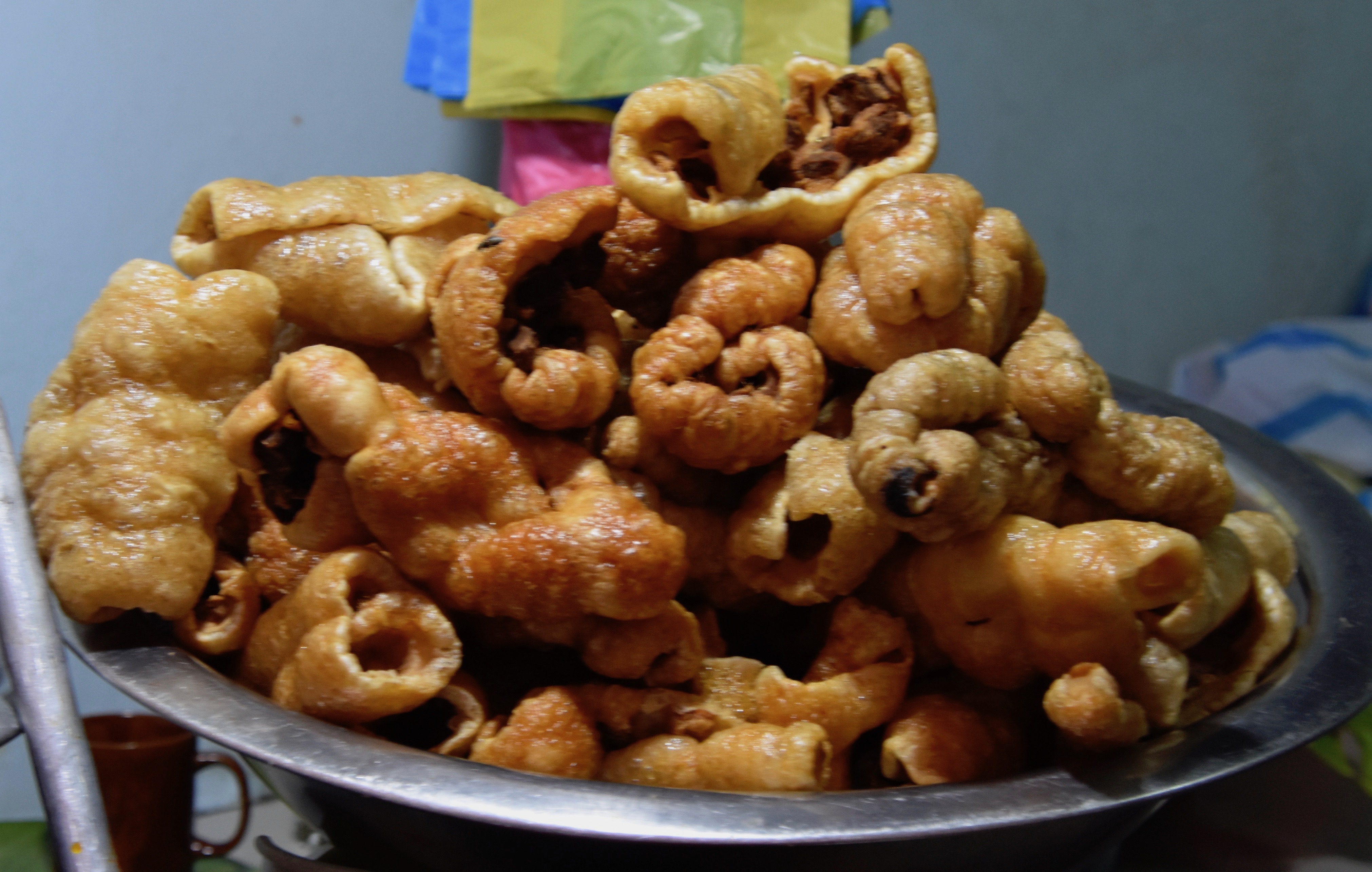
Tamales anyone?
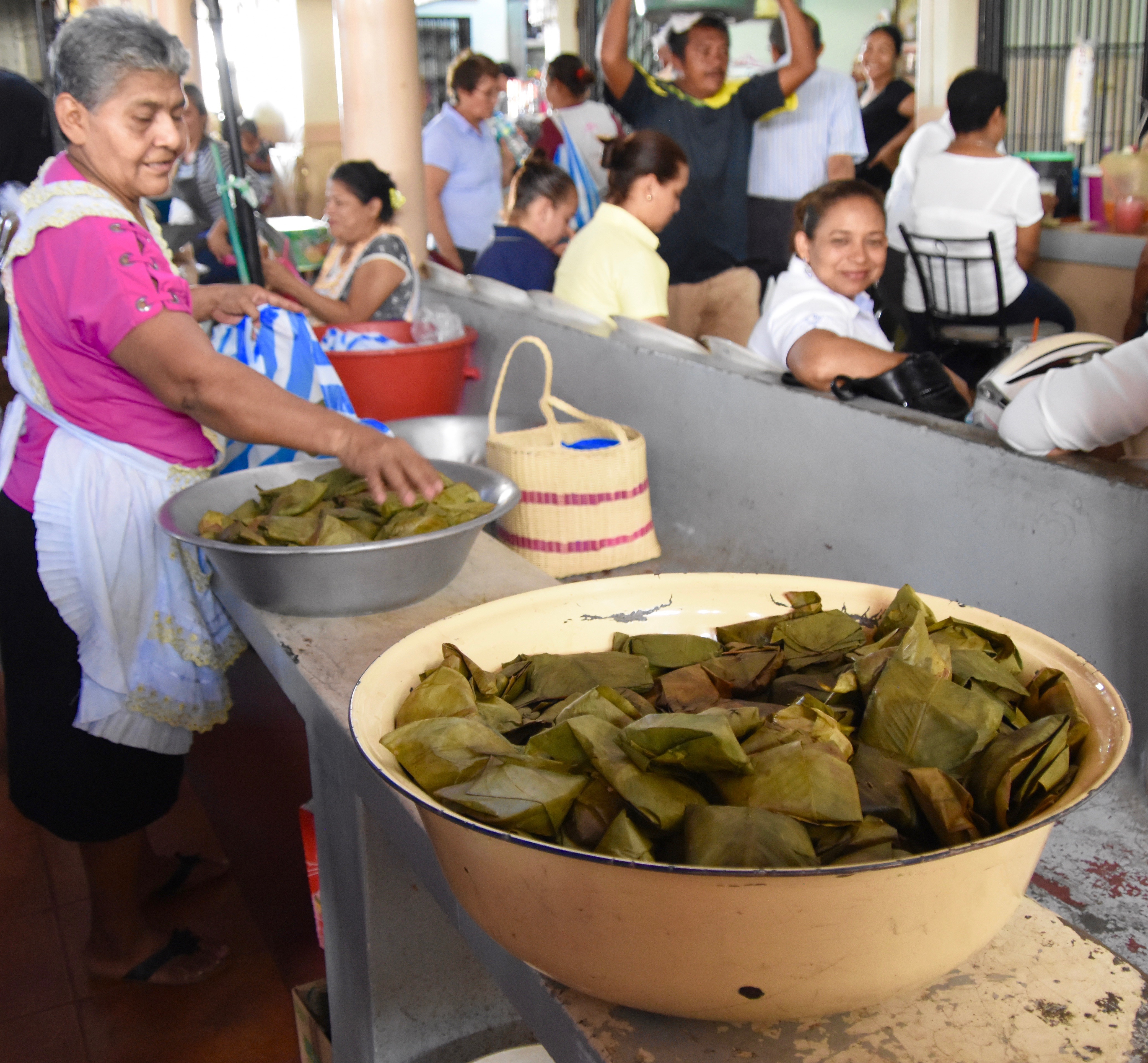
The Leon market is loud, vibrant and in places a bit claustrophobic, but most good markets tend to be. While there are always new fruits and vegetables and hot dishes to try, there are also things for sale that might be upsetting. I personally find the Latin American song bird markets, particularly the one in Guadalajara, saddening as I know most of the birds were caught in the wild. Here in Leon the sight of live iguanas, feet bound, and ready for someone’s stew pot might be off putting to some. I know some people who would buy them just to let them go and I did feel some pity for their plight, but they are not endangered and who am I to judge what a Nicaraguan should and should not eat?
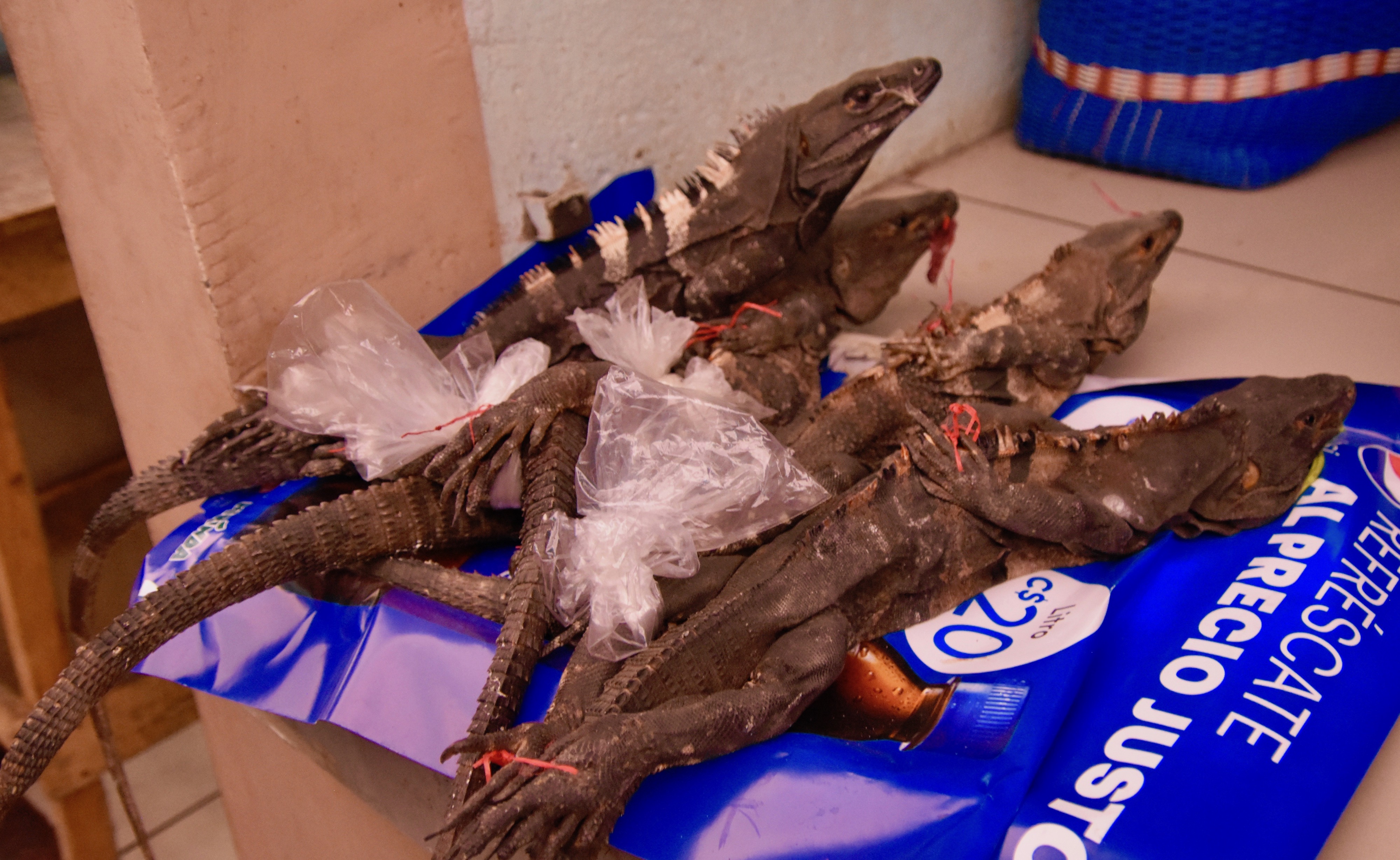
Well actually, I will pass judgment on these next items for sale. Those are sea turtle eggs and given that earlier in this trip the group visited the world’s first sea turtle conservancy in Tortuguero, Cost Rica it really does seem strange that one country is fighting to save them and another is still harvesting their eggs.
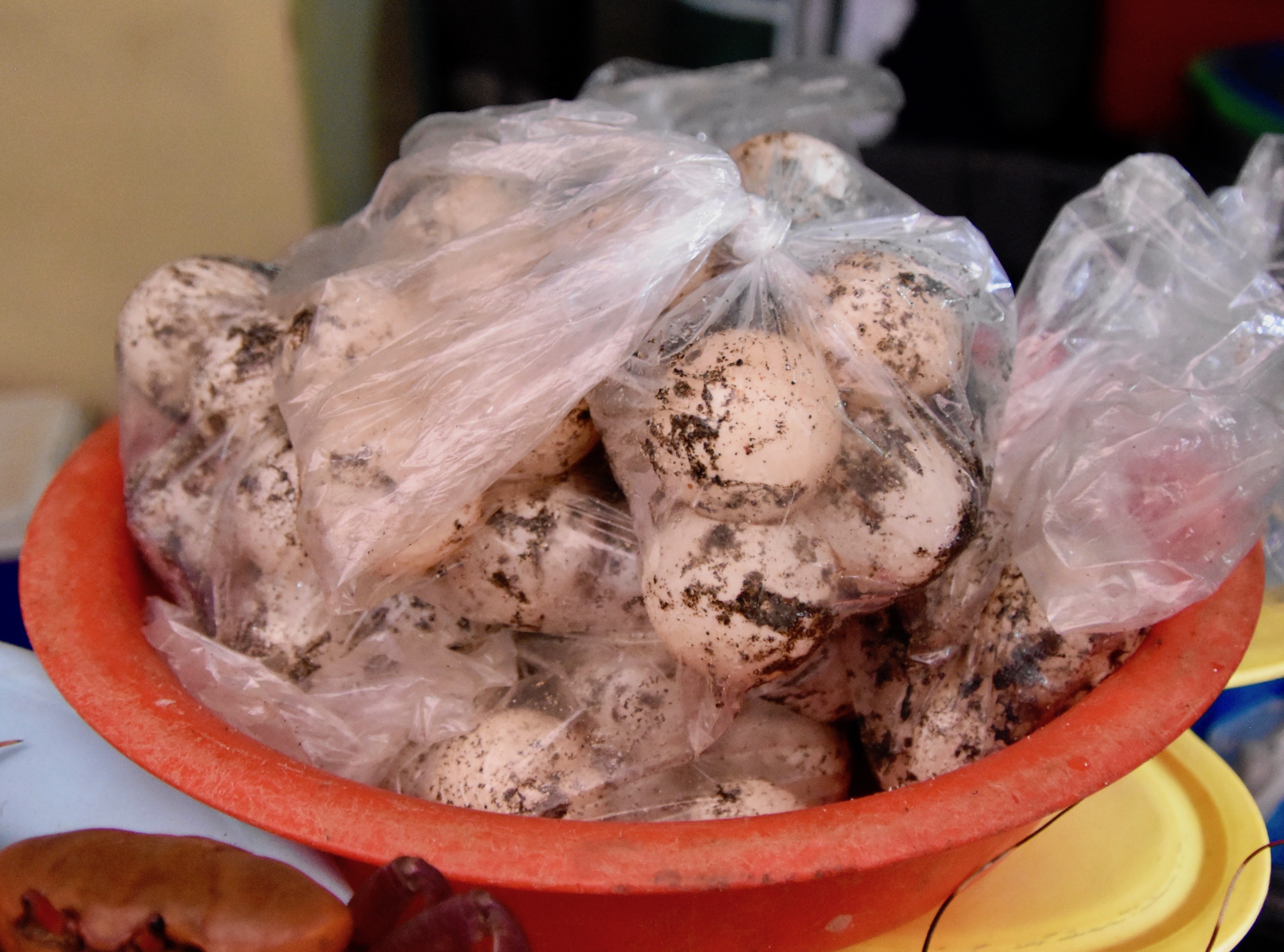
Other exotic foods for sale include live land crabs – I doubt that they’ll get anyone emancipating them.
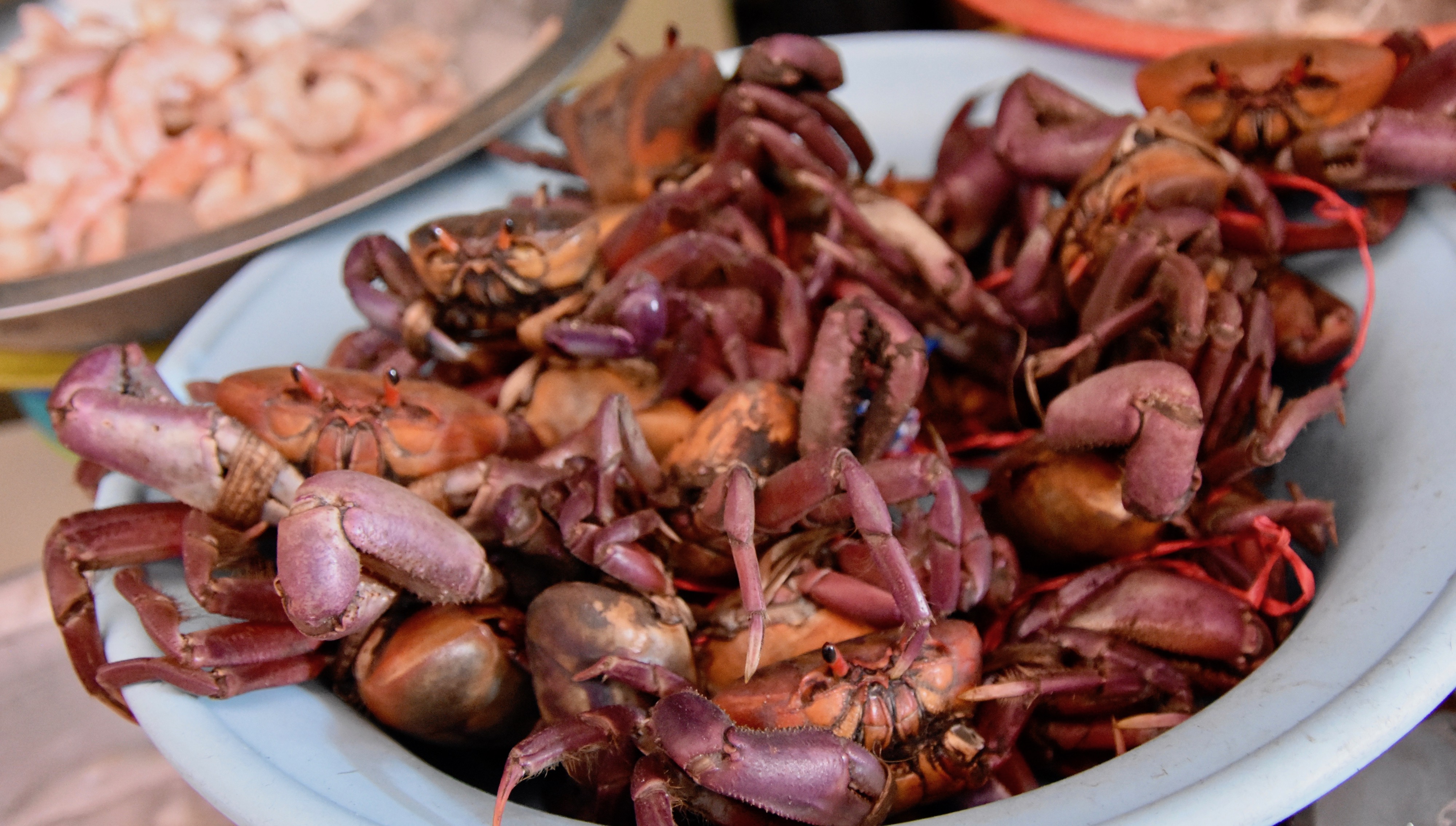
And Nicaraguan lobster. These are definitely doomed and make me wish I had seen some on the menu at any of the restaurants we dined at.
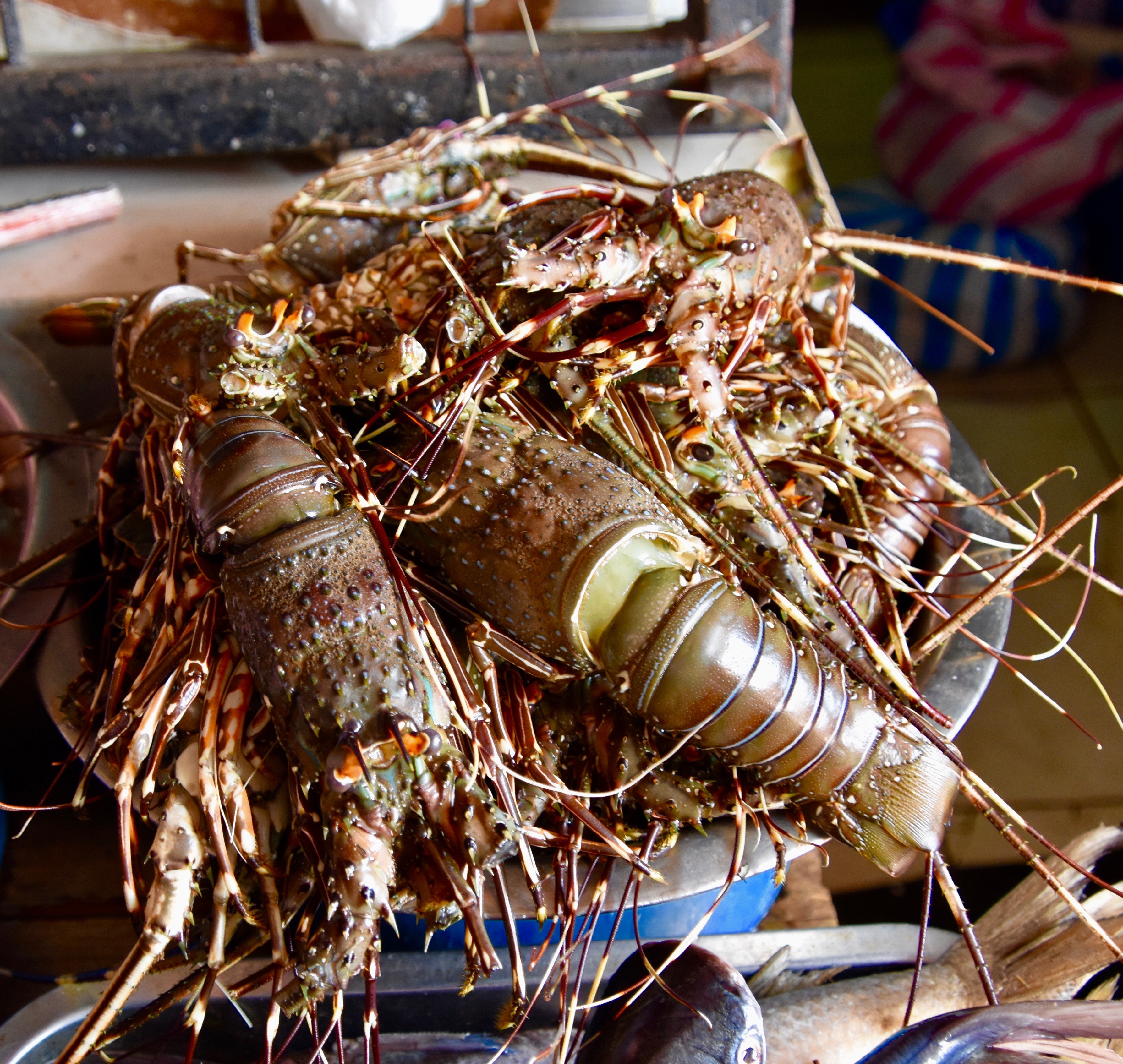
.We exited the market and not paying attention, I almost knocked over this table of salt fish. What would that have cost me?
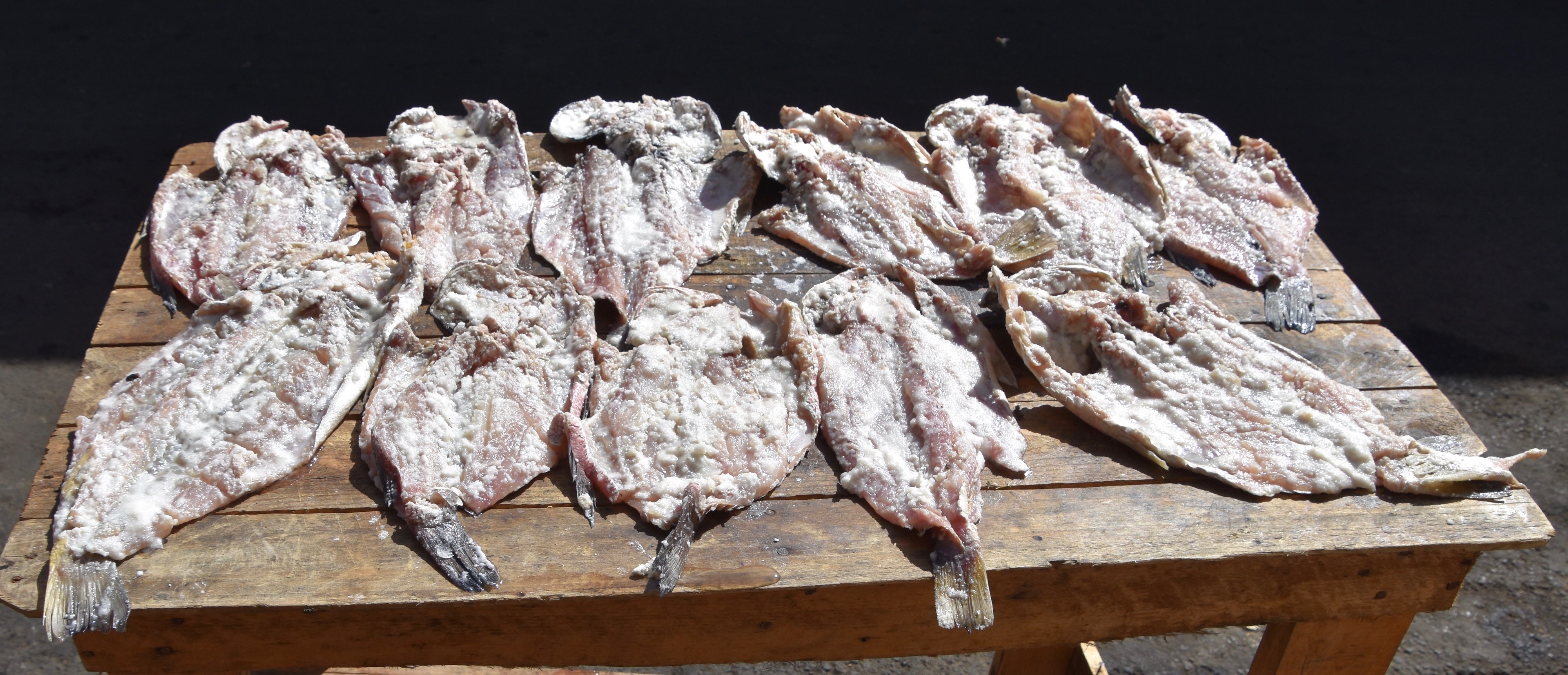
Outside the market people were piling into one of the small covered trucks that pass for public transport in Leon. Somehow the market didn’t seem so crowded now.
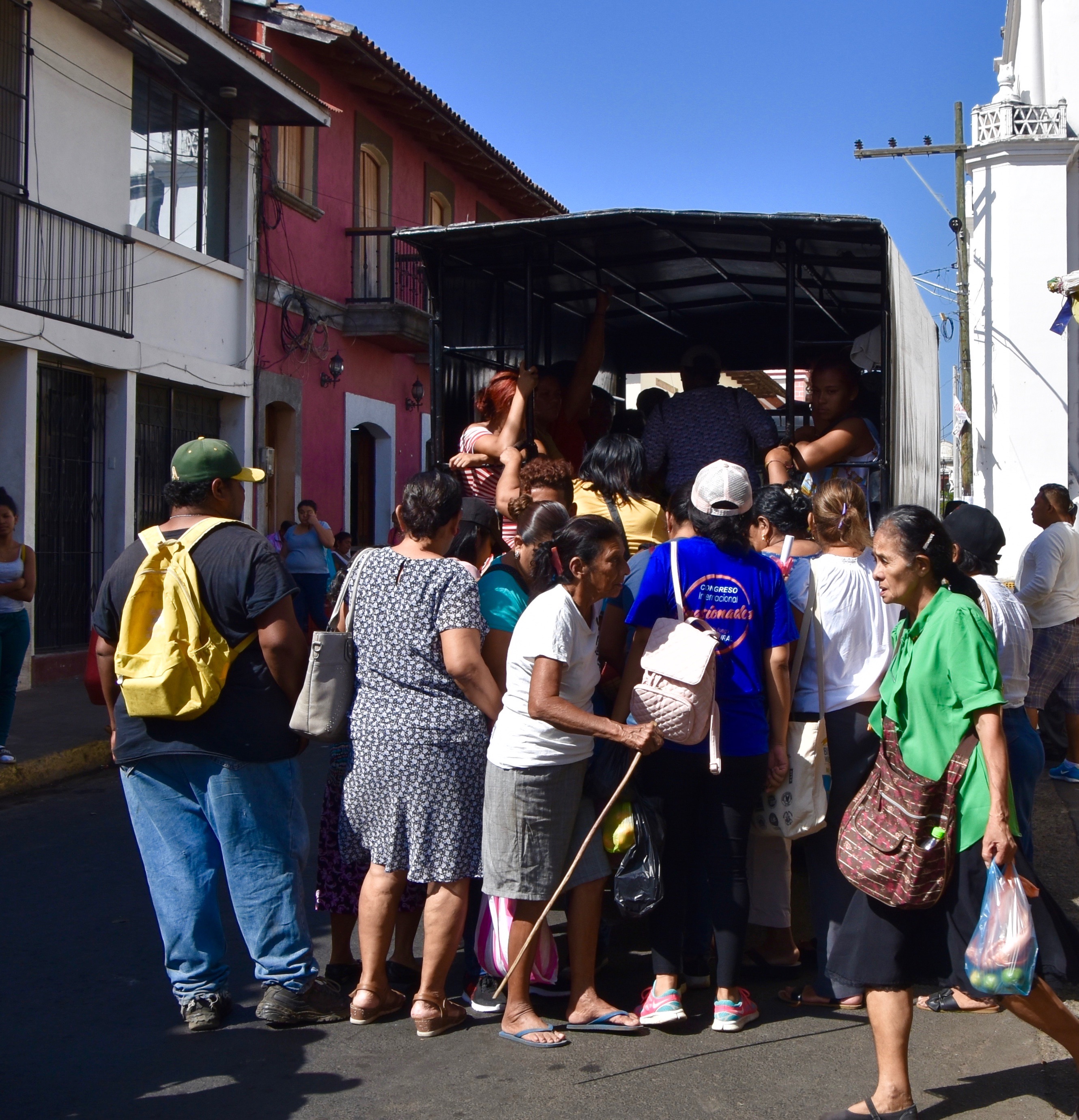
Just down the street there was a gathering of children clad in their school uniforms. There was an ice cream vendor and the mothers collecting their kids had little choice but to give in to their pleas. And why not if you can get a smile like this just for a few cordobas?
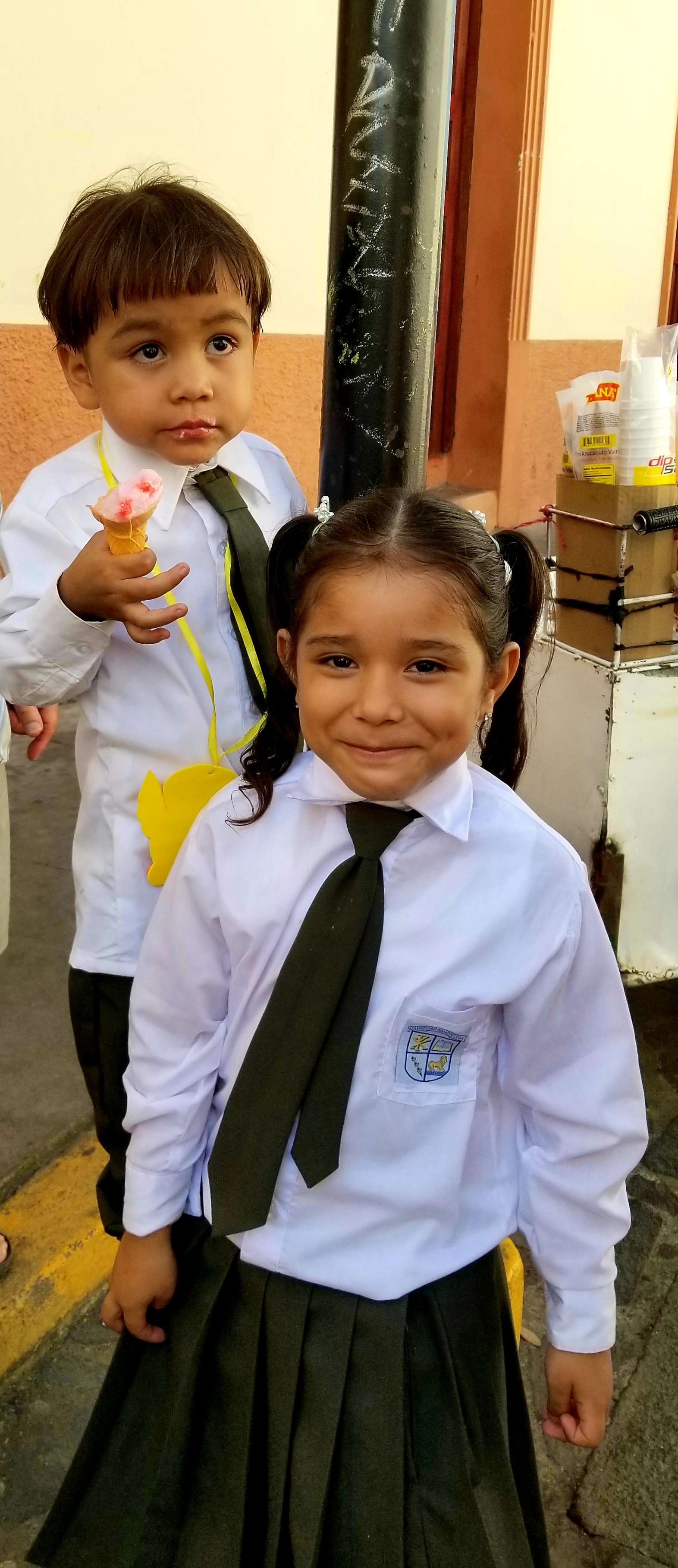
And so ends our journey through the country of Nicaragua. Thank you Victor for letting us visit this beautiful, but troubled land. Next stop El Salvador.

